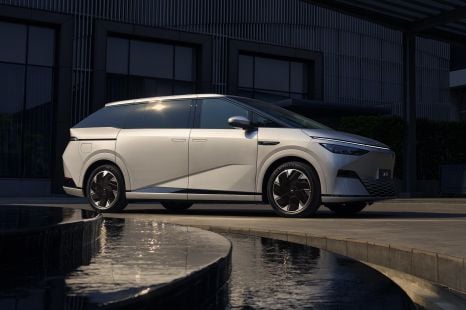

William Stopford
Will 2026 be the year of the people mover in Australia? China seems to think so
8 Hours Ago
Having seven seats is handy, but not everyone who needs a third row has space for a massive car. That's where this trio steps in.

Contributor
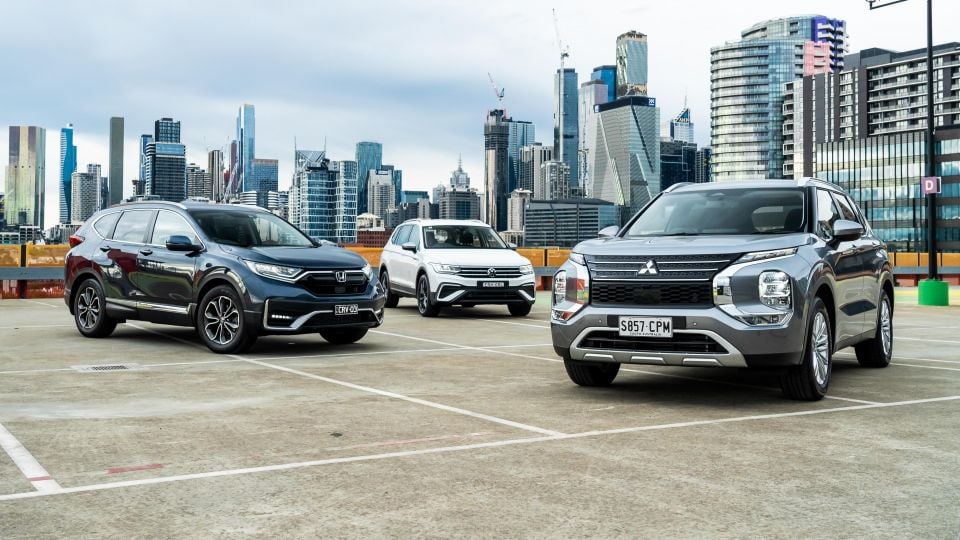

Contributor
Having seven seats is handy, but not everyone has space for a hulking four-wheel drive at home. That’s where cars like the trio on test here come in.
The Outlander, Tiguan Allspace, and CR-V are all slightly smaller than seven-seaters like the Hyundai Santa Fe, making them easier to drive in tight spaces, but still feature the versatility of third-row seats designed for kids.
The Outlander is the new kid on the block here. Launched in 2021, the new model is bigger and packs more tech than its predecessor. It’s also more expensive than before, as Mitsubishi looks to move upmarket across its range.
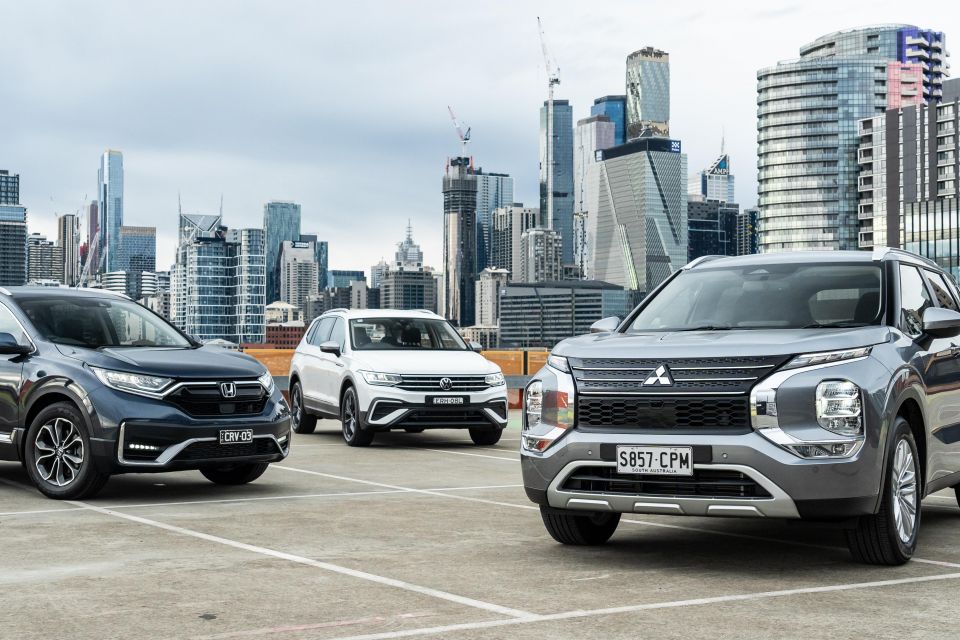
Volkswagen also has a new Tiguan Allspace, although it’s a facelift rather than a full overhaul. Like the five-seater, the seven-seat Tiguan has a massaged exterior design, and gains a newer infotainment suite than that of its predecessor.
Finally, the CR-V. It’s comfortably the oldest car on test, and has the smallest body. What it lacks in size though, it makes up for with standard equipment. Price-wise it’s closely aligned with the Tiguan, but it’s a high-specification model with luxuries like leather and a sunroof.
Which of these seven-seaters best balances mid-sized-ish dimensions with a practical, versatile interior without breaking the bank?


Mitsubishi Outlander LS FWD
The Outlander LS sits one step above the base level, with a sticker price of $39,490 before on-road costs.
That equates to a drive-away price of $43,700 in NSW, according to the Mitsubishi Australia website.
The petrol (a PHEV is also available) range kicks off at $35,990 before on-roads for the LS five-seat front-wheel drive, and extends to $52,490 before on-roads for the Exceed Tourer.
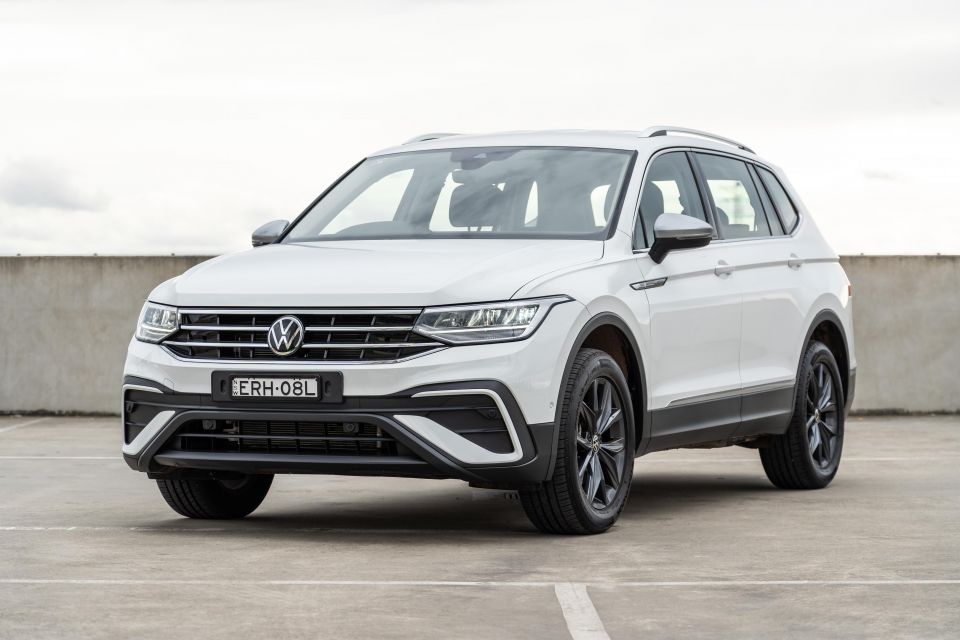
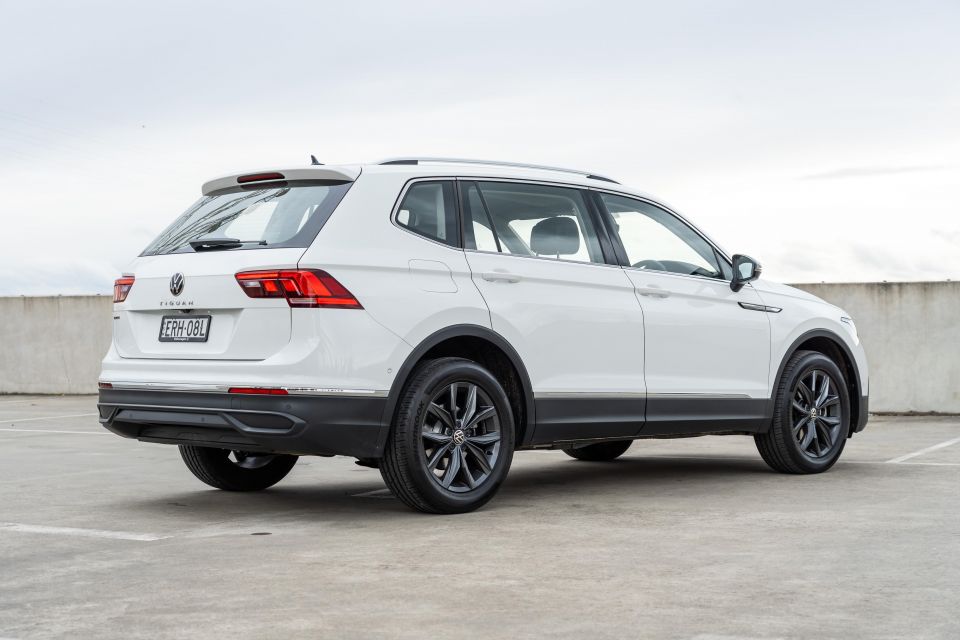
Volkswagen Tiguan Allspace 110TSI Life
The base Tiguan Allspace has a sticker price of $44,590 before on-road costs, up $5100 on the Outlander.
That equates to a $48,197 drive-away price in NSW, according to the Volkswagen Australia website.
The range extends to $61,690 before on-road costs for the range-topping Allspace 147TDI R-Line.
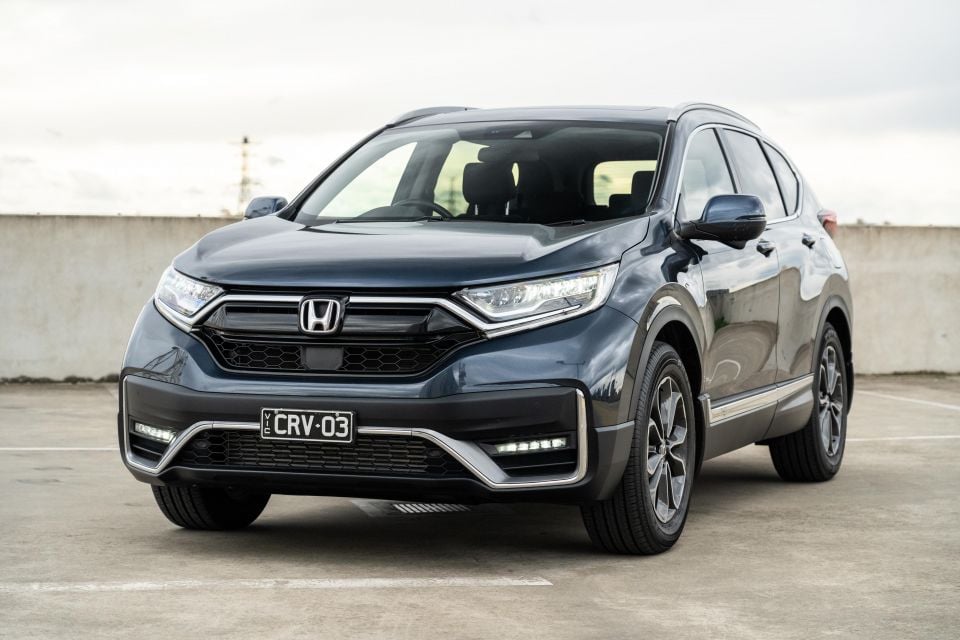
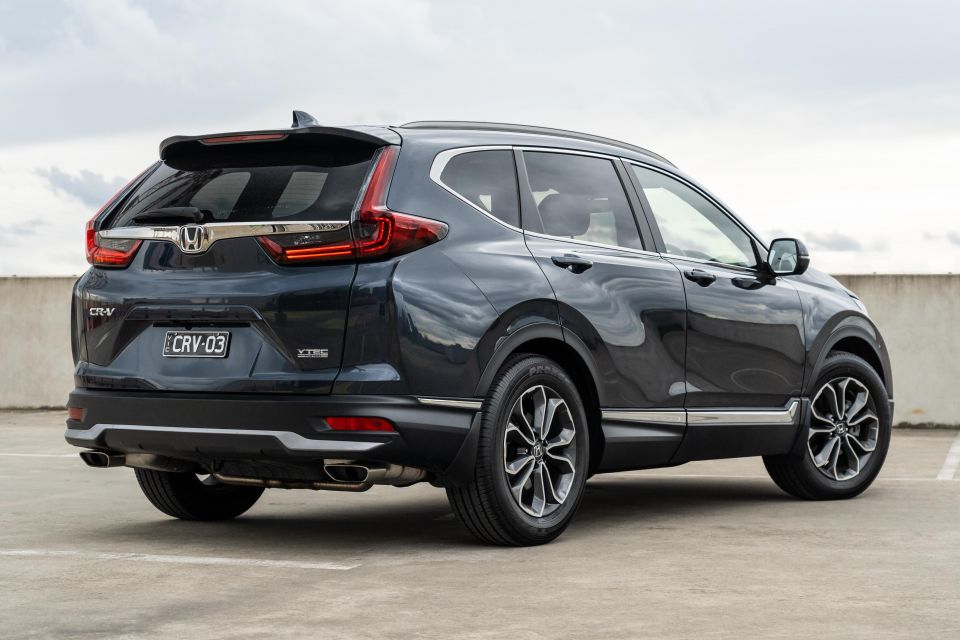
Honda CR-V VTi L7
Honda no longer quotes list prices, and instead has national drive-away pricing across its range.
Based on its $49,500 drive-away price, the CR-V is the most expensive car here. It’s also the best-specified though, as we’ll outline below.

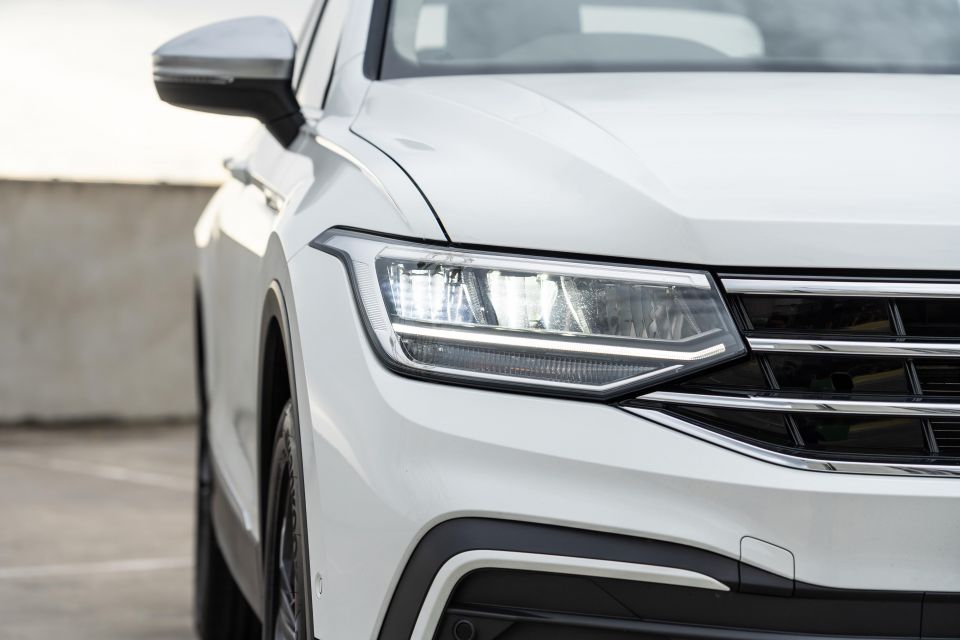

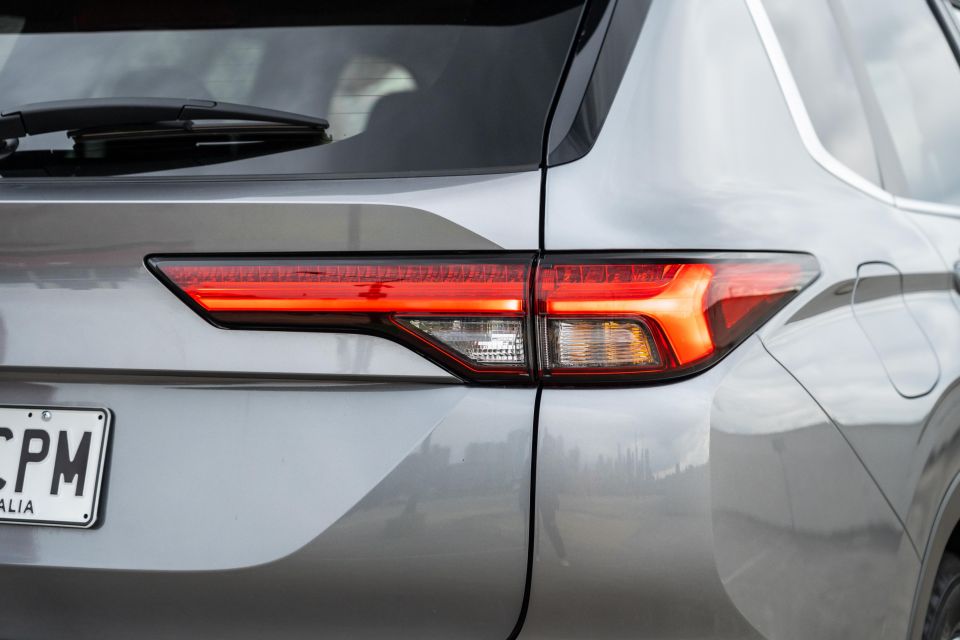
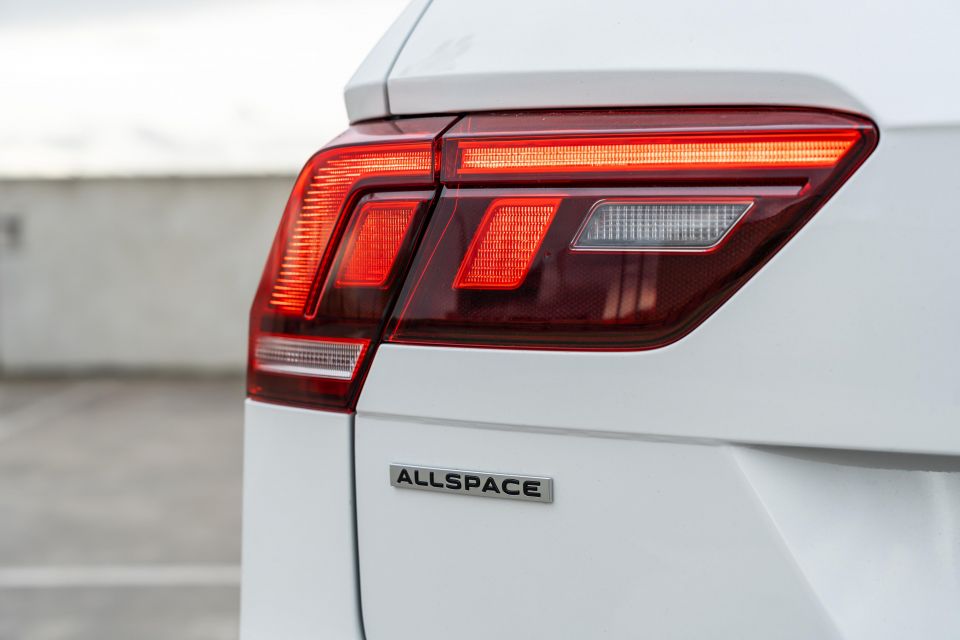

Standard equipment shared by all three models includes:
Equipment unique to the Outlander includes:
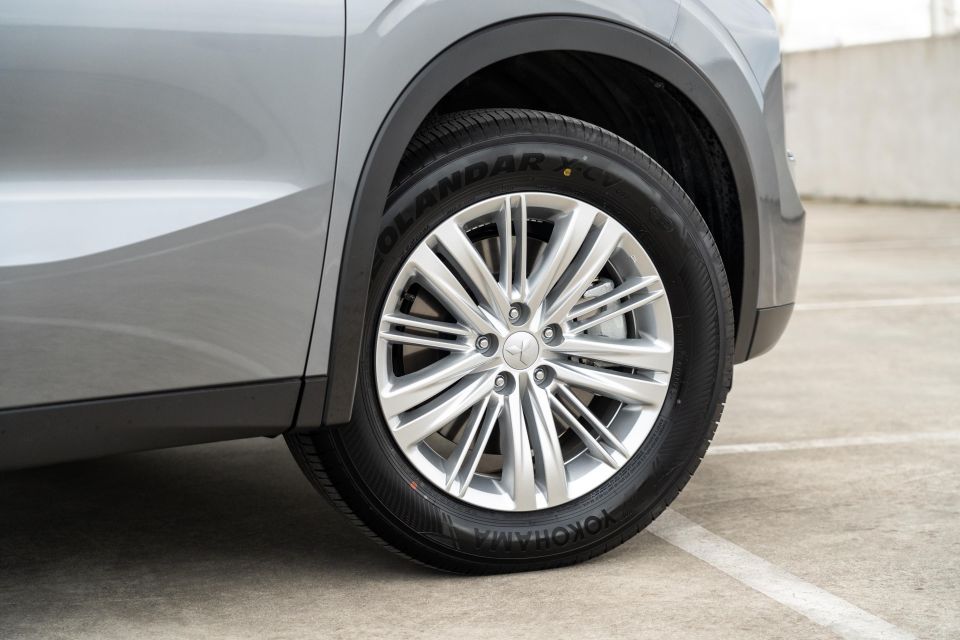
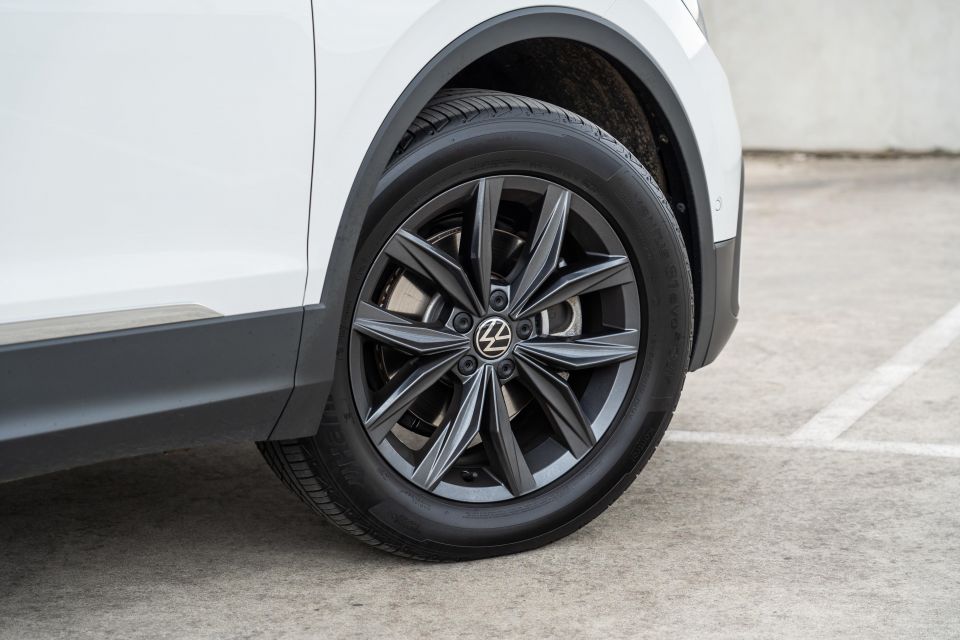
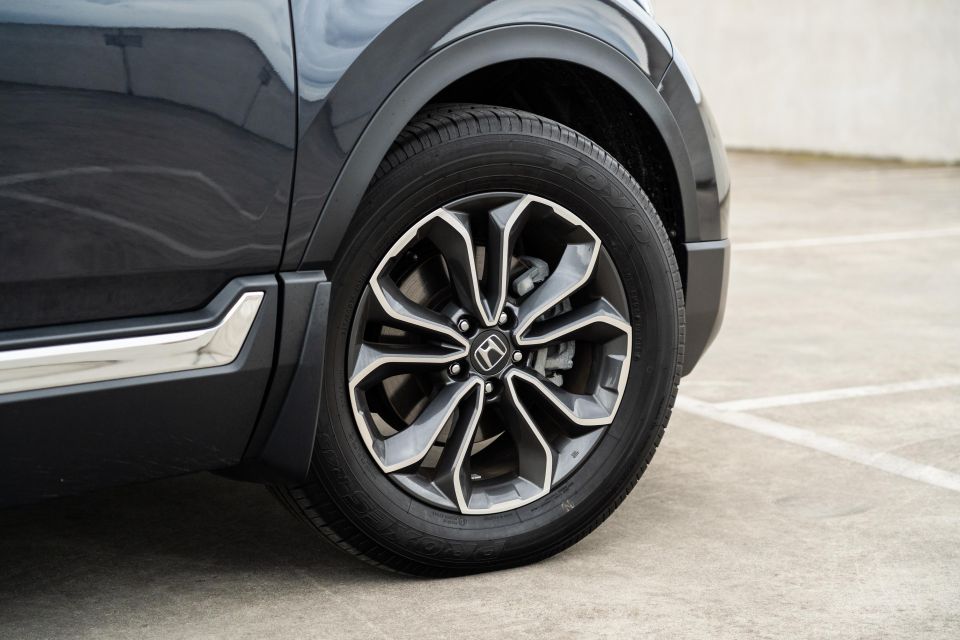
Equipment unique to the Tiguan includes:
Equipment unique to the CR-V includes:

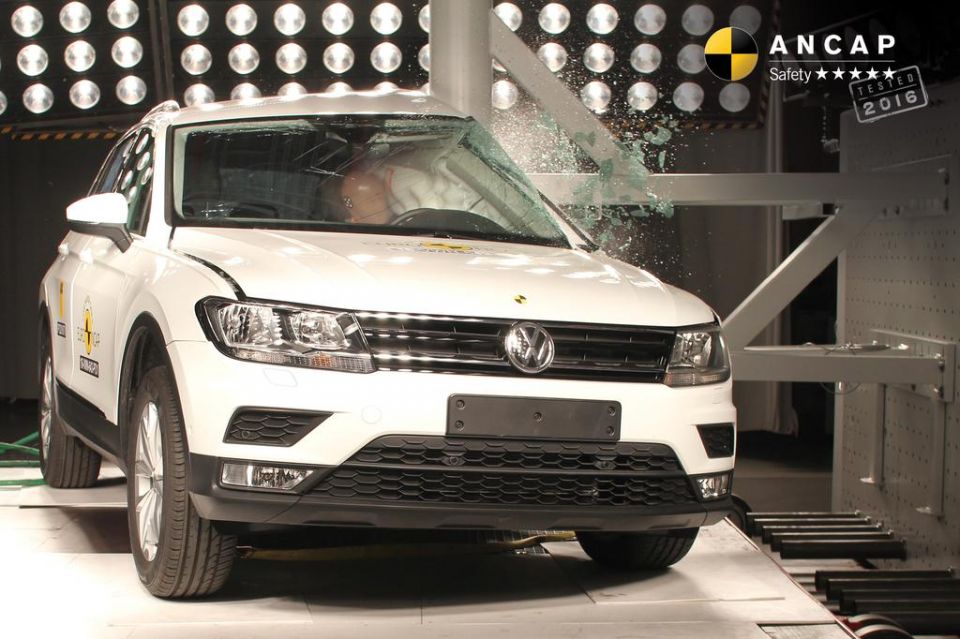

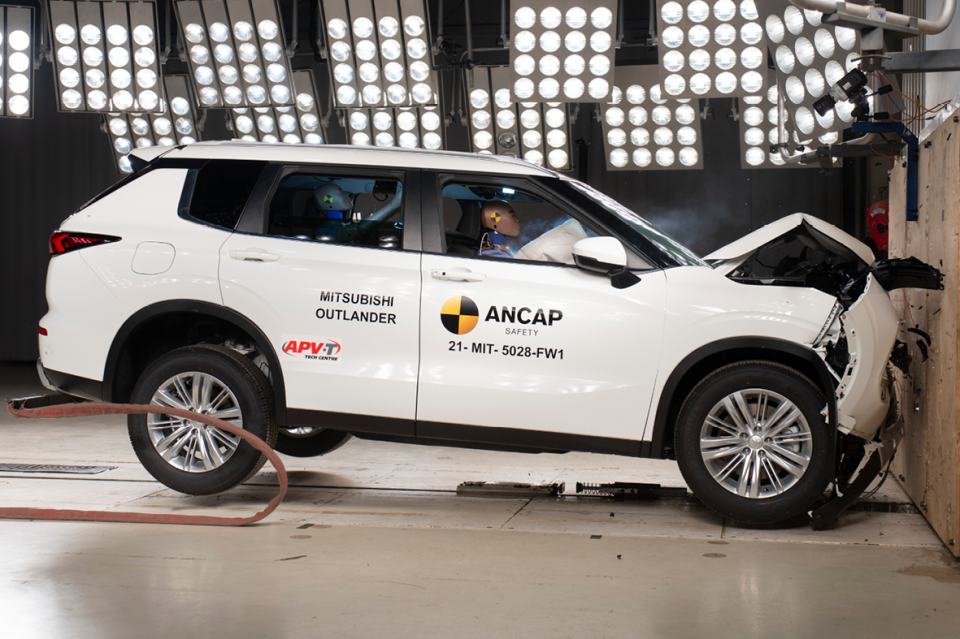
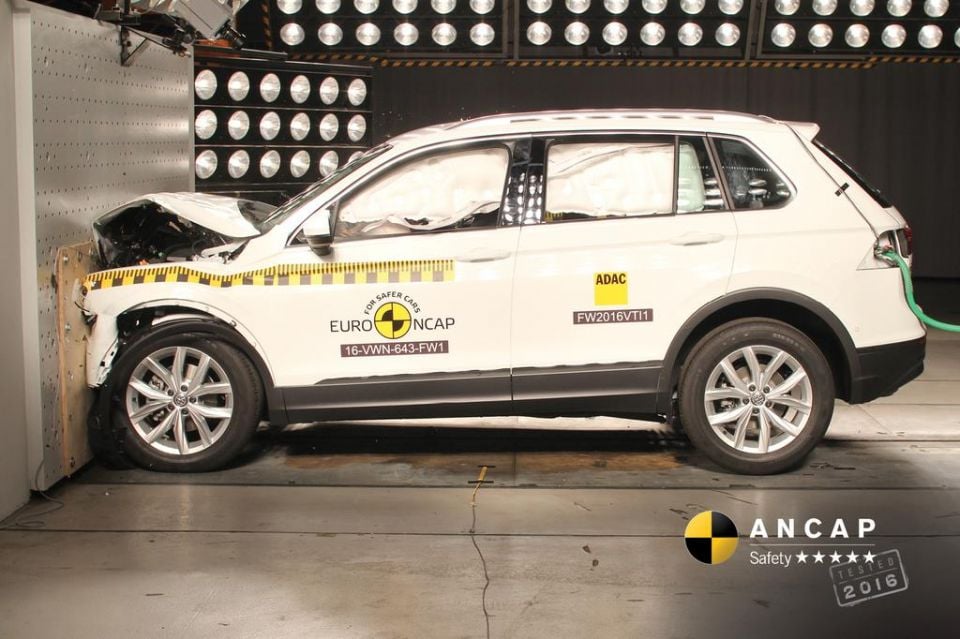
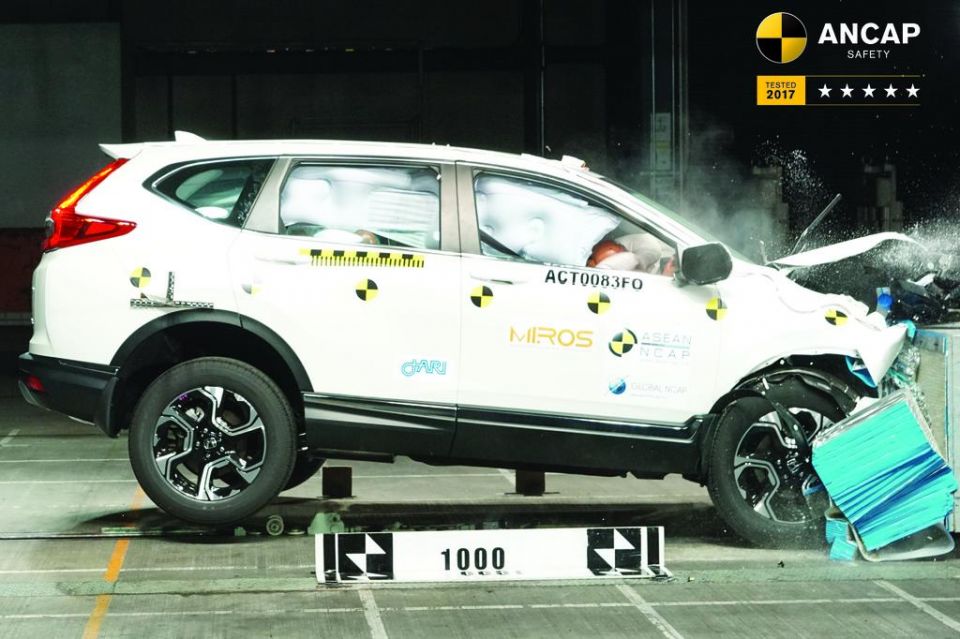
Mitsubishi Outlander
The 2022 Mitsubishi Outlander wears a five-star ANCAP safety rating based on testing carried out in 2022.
The received an adult occupant protection rating of 83 per cent, a child occupant protection rating of 92 per cent, a vulnerable road user protection rating of 81 per cent, and a safety assist rating of 83 per cent.
It features eight airbags.
Volkswagen Tiguan
The 2022 Volkswagen Tiguan Allspace wears a five-star ANCAP safety rating based on testing carried out in 2016.
The Tiguan scored 96 per cent for adult occupant protection, 80 per cent for child occupant protection, 68 per cent for vulnerable road user protection, and 68 per cent for safety assist.
It features seven airbags.
Honda CR-V
The 2022 Honda CR-V wears a five-star ANCAP safety rating from based on testing carried out in 2017.
It scored 14.76 out of 16 for the frontal offset test, 16 out of 16 for the side impact test, and two out of two for the pole test, for a total score of 35.76 out of 37.
It features six airbags.
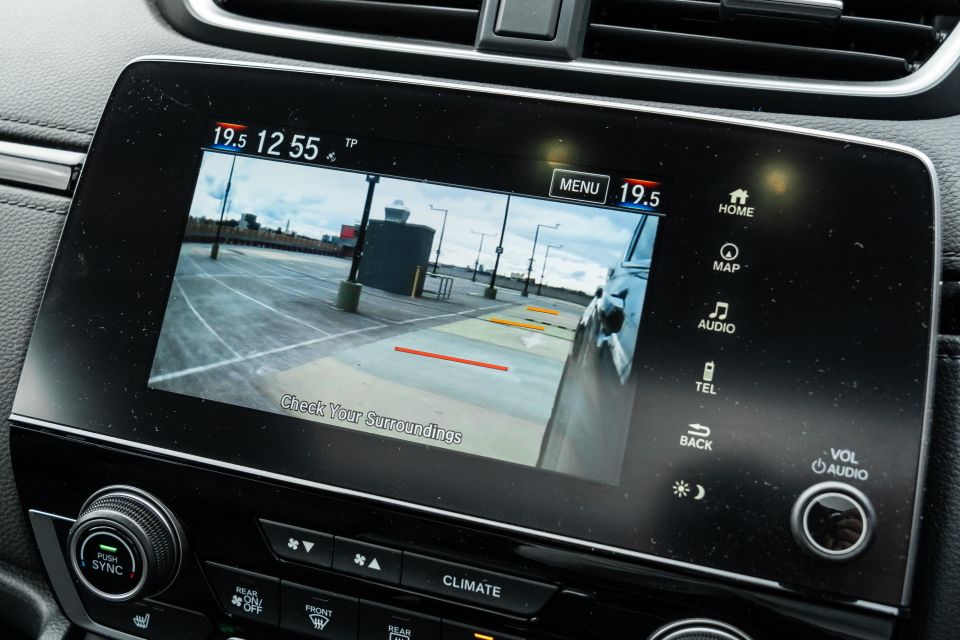
Standard safety equipment on all three cars includes:
Features unique to the Tiguan and Outlander include:
The Outlander is the only vehicle with junction AEB, which brakes if the driver pulls out of an intersection and is at risk of being t-boned.
The only feature unique to the CR-V is its LaneWatch camera, which sends a live feed of what’s in your left-hand blind spot to the infotainment system when you indicate. It’s fitted in lieu of a conventional blind-spot monitoring system.
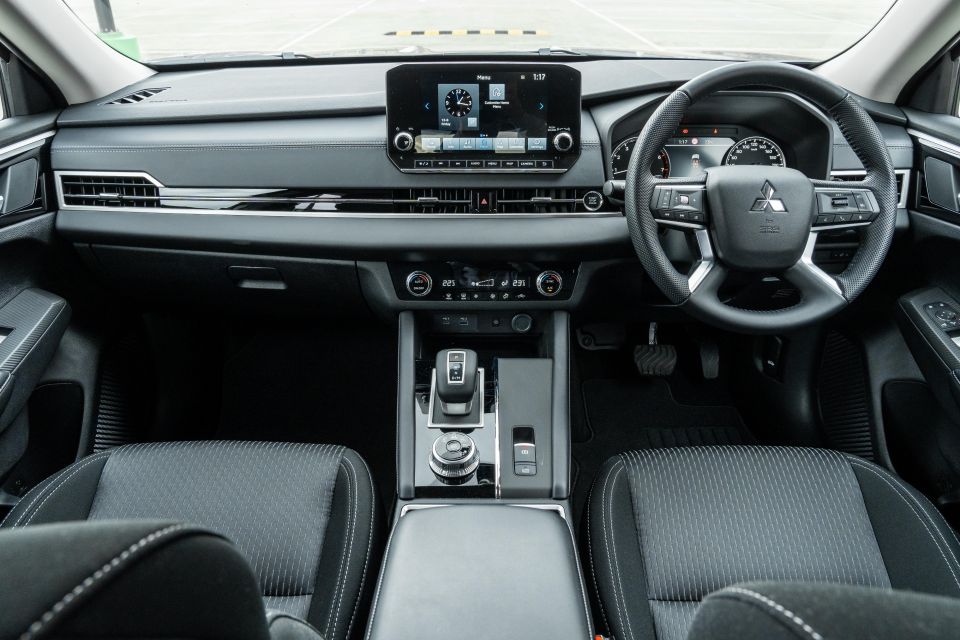
Mitsubishi Outlander
The Outlander is the cheapest car on test here, and it feels it behind the wheel. It’s big and airy, but the grey cloth seats, plasticky climate control dials, and more basic trip computer readout give away the fact this is close to a base model.
The fundamentals are good up front. The manually-adjusted driver’s seat is supportive, and the driving position is more accomodating than was the case in the last Outlander. With its leather trim and silver highlights, the steering wheel feels like a quality item; the same can’t be said for the brittle indicator stalks.
As the newest car here, it would be reasonable to expect the Outlander to be the technology standard-setter here. In reality, it offers a full feature set but doesn’t look or feel particularly up-to-date. It’s more modern than the Honda’s creaky setup, but the Volkswagen comfortably has it covered.
Its graphics are blocky and basic, and it’s already a bit laggy at times. Wireless CarPlay is its saving grace, allowing you to sidestep the factory software without removing your iPhone from your pocket. Android users still need to plug in.
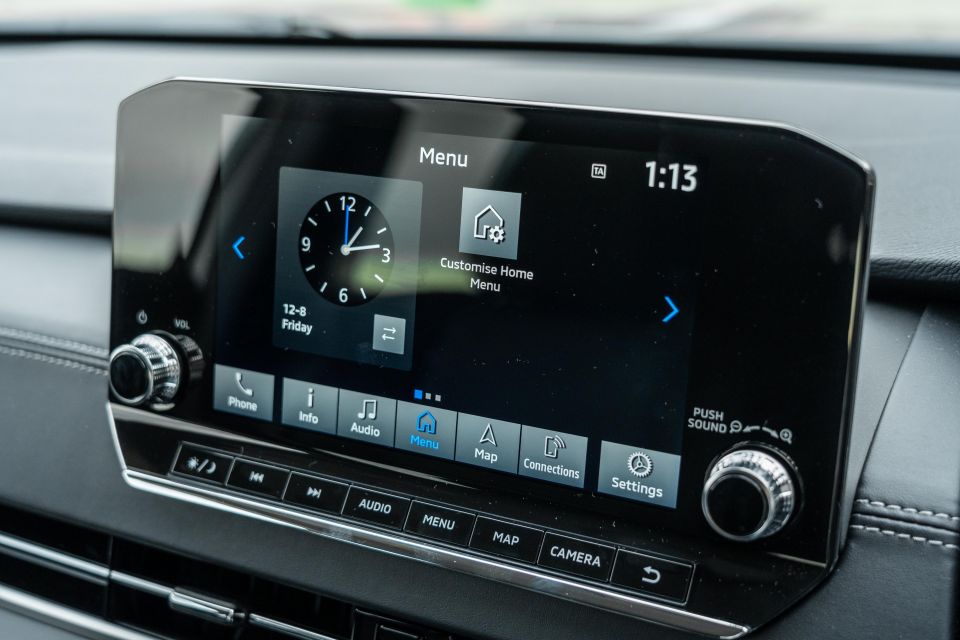
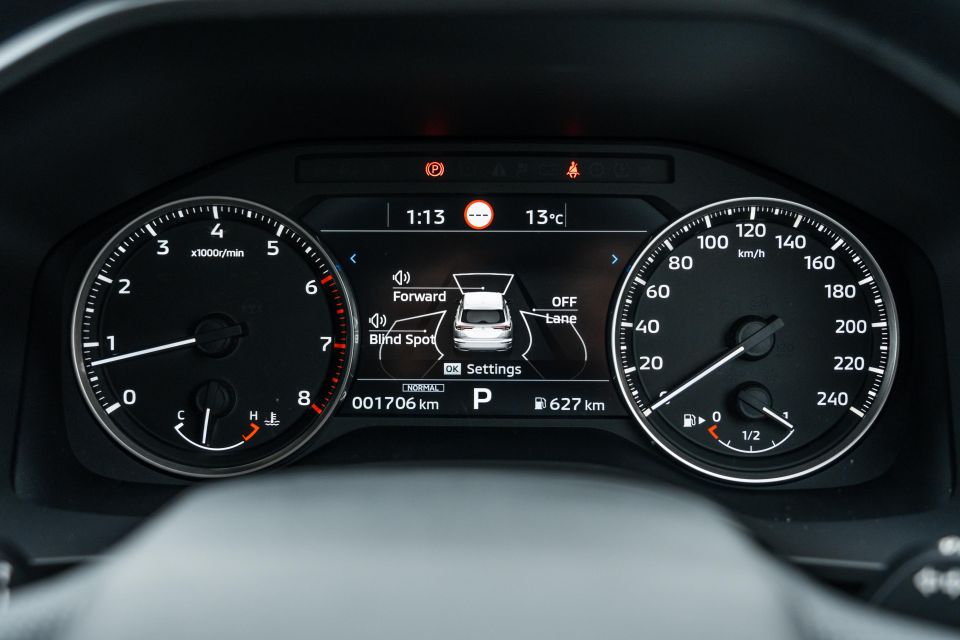
It’s a bit disappointing Mitsubishi didn’t do more to move the game forward, because a big screen isn’t enough to stand out in 2022.
The trip computer between the simple dials offers plenty of information, but it’s busy and the graphics look basic compared to what the VW offers. Mitsubishi does offer a digital instrument cluster on higher-end models.
At least Mitsubishi hasn’t abandoned proper climate controls, so you don’t need to go digging into the touchscreen to adjust your temperature and fan speed.
There’s plenty of storage up front, from the dual cupholders to the wireless charge pad at the base of the dashboard. The door pockets will happily swallow a water bottle, and there’s plenty of space for road trip snacks in the underarm storage bin.
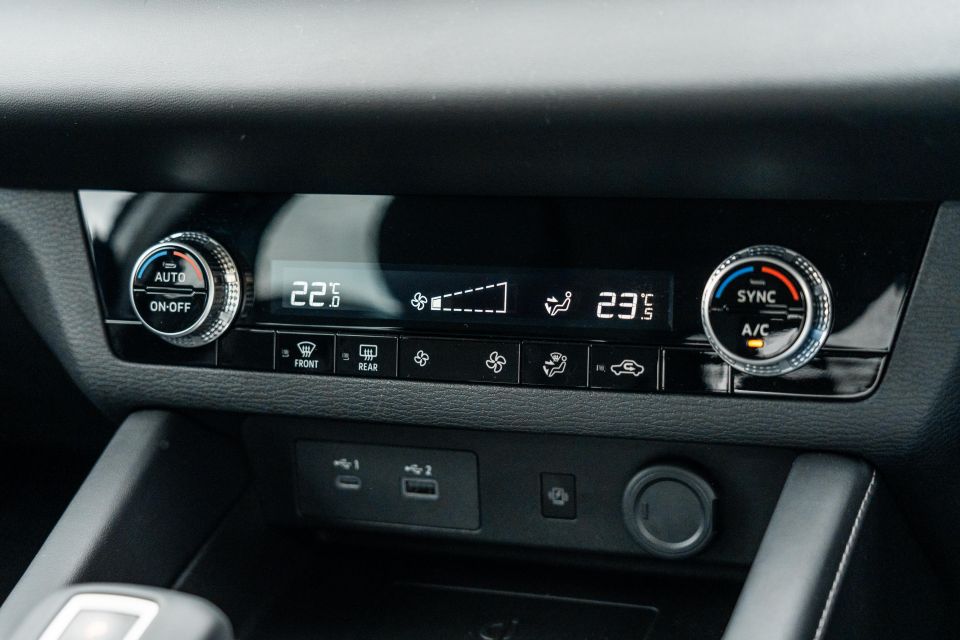
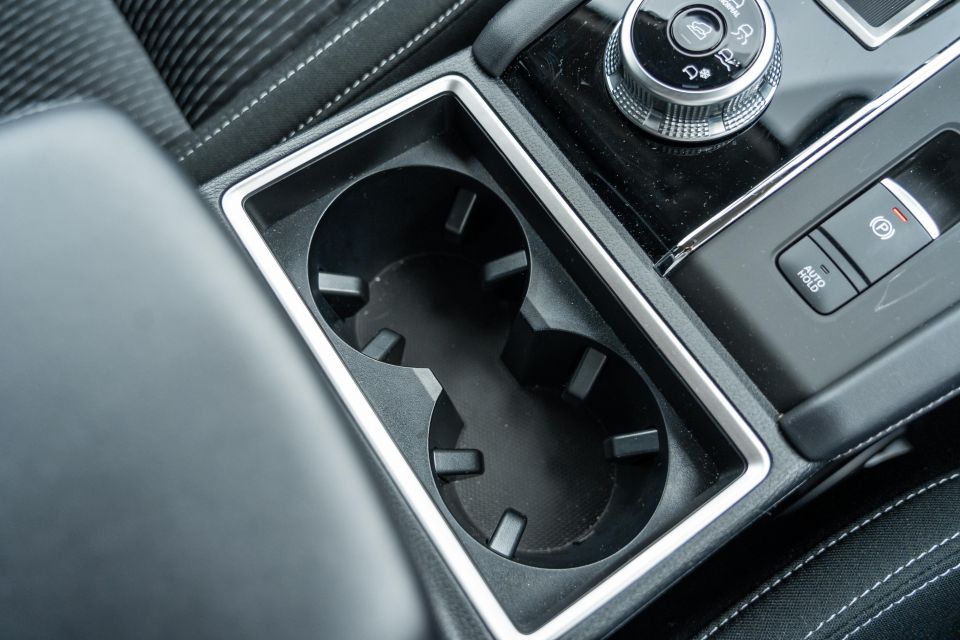
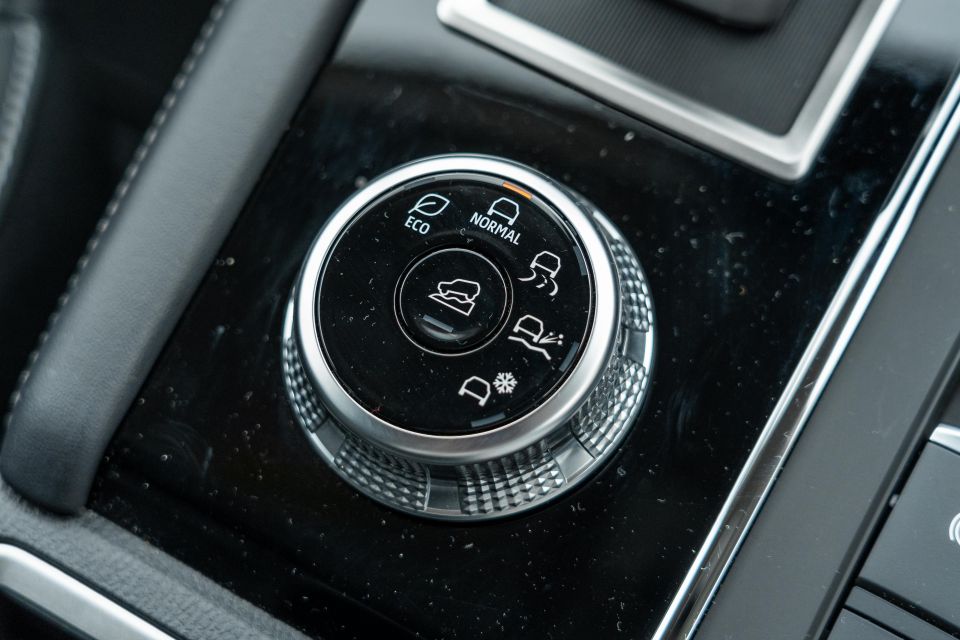
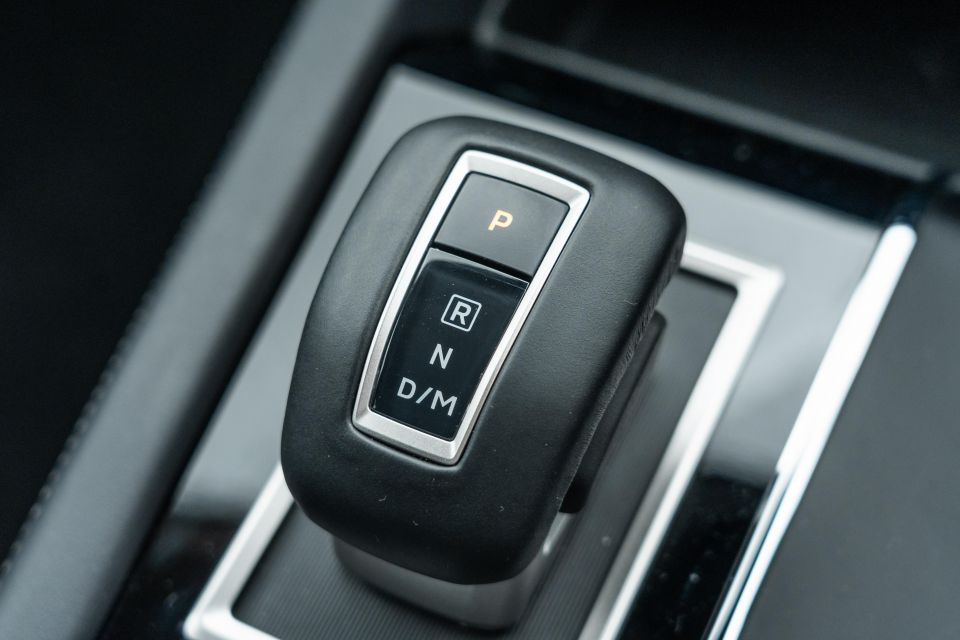
The Outlander’s chunky exterior dimensions mean there’s solid legroom in the second row. You’ll fit full-sized adults behind full-sized adults, and the bench is broad enough to accomodate three teenagers without too much stress.
Legroom with the rear seats in place is similar to in the CR-V. The raised second row means vision outwards is good for small kids, but it also means long-legged passengers will feel as if their knees are butting into the top of the seat.
You get air vents back there, and the centre seatback folds down to create an armrest. Unfortunately when you fold it there’s nothing stopping bags from the boot sliding into the cabin. Both the CR-V and Tiguan have fold-down armrests without forcing you to make the same compromises.
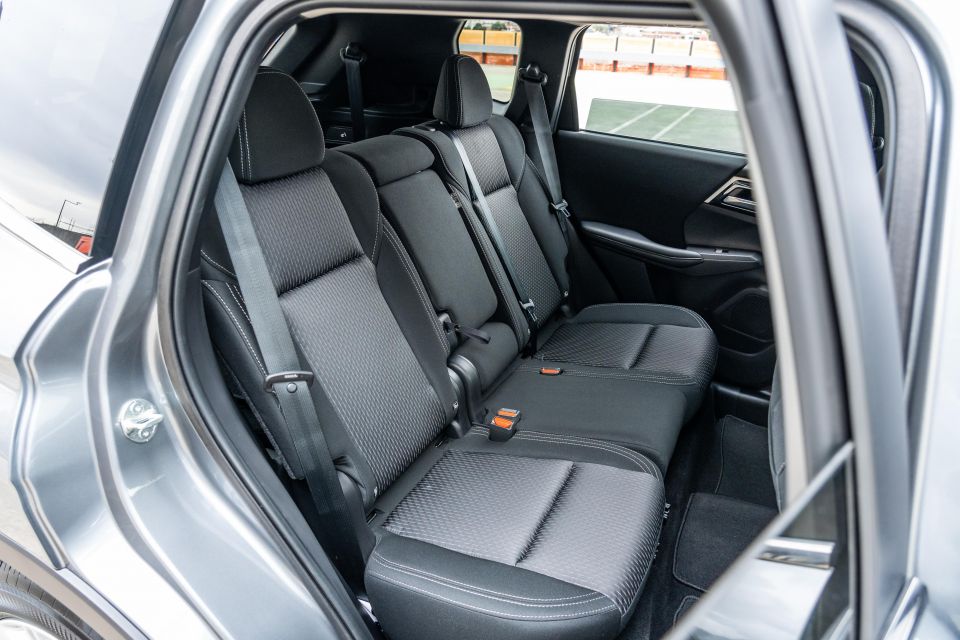
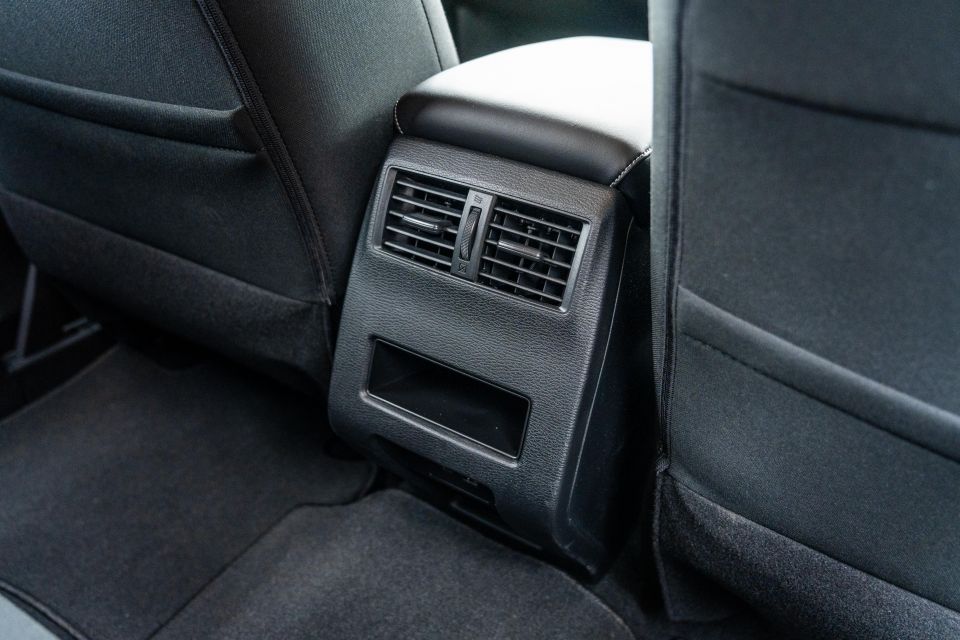
Rear-seat passengers get air vents and two USB ports, but no temperature controls.
Access to the third row is tighter than in either the Tiguan or CR-V, despite the second-row bench sliding and tilting forwards. Once there, headroom is the worst of the trio on test, and legroom is on a par with the ageing Honda with the second row slid forward.
They don’t get air vents, although third-row passengers do get a single cupholder cut into the plastic moulding over the wheel arches. It’s also worth noting how small the rear window is relative to its rivals. It’s like a porthole.
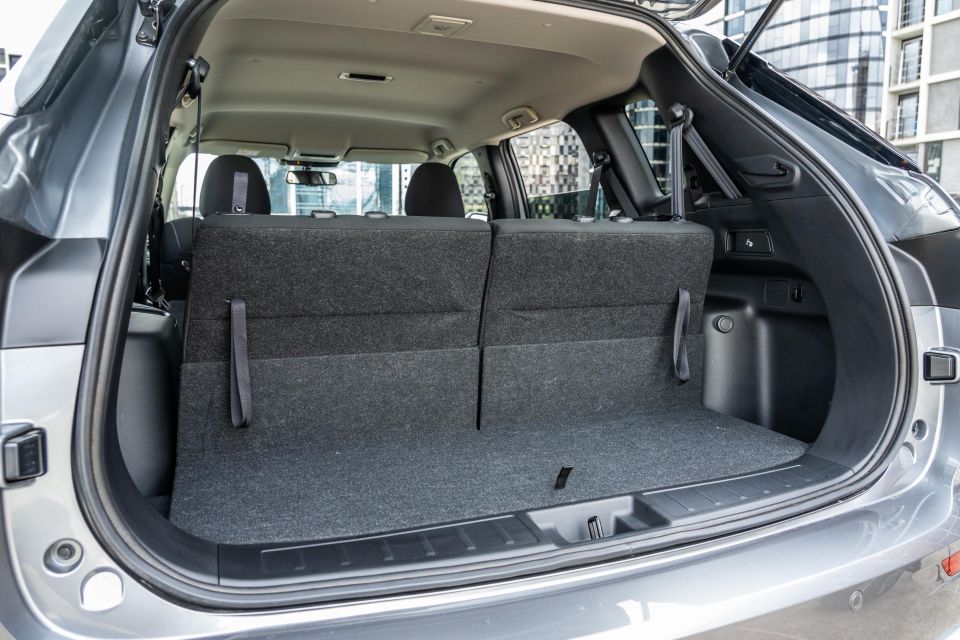
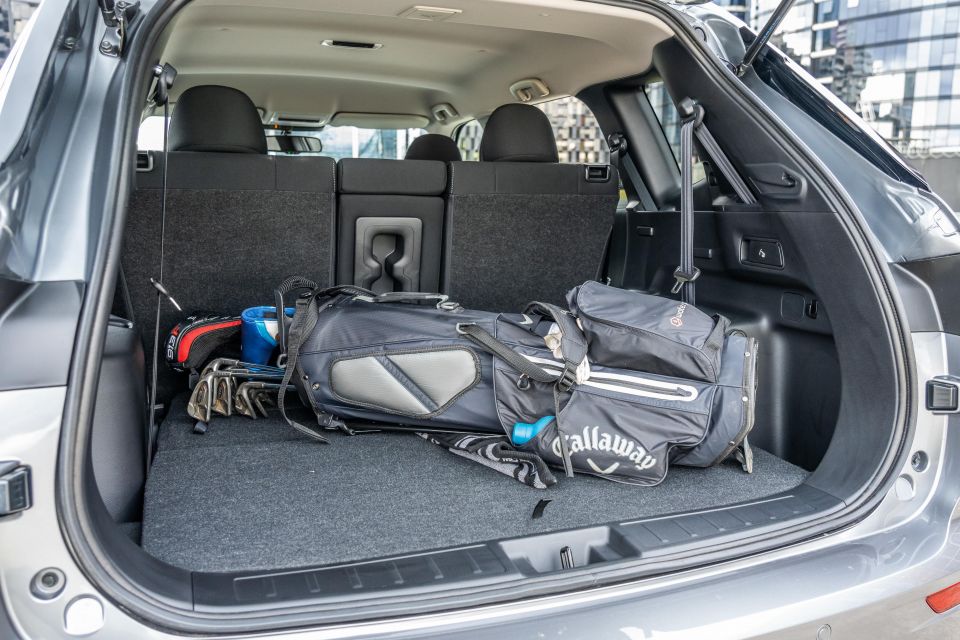

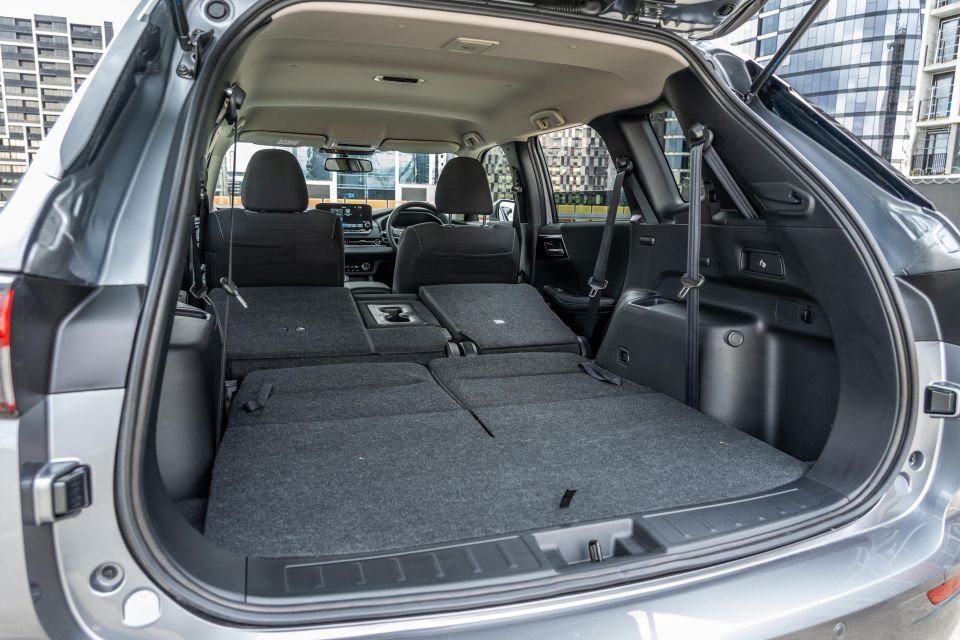
Where expert car reviews meet expert car buying – CarExpert gives you trusted advice, personalised service and real savings on your next new car.
Erecting or lowering the third-row seats is simple, but the headrests aren’t integrated. Instead, you need to install them when you want to use the seats, and store them with the cargo beneath the floor when you aren’t.
There’s a claimed 163L of boot space with the third-row seats in place, expanding to 478L with them folded.
That expands to 1461L with them folded. The boot itself is the best of the three cars. The floor is perfectly flat, and there are no awkward steps or holes back there.
The boot lid is massive and isn’t power assisted, but it’s light enough to open and features a handle that should make it easier for short owners to shut it. Given the price difference between the Outlander and its rivals, we can understand why there’s no powered tailgate.
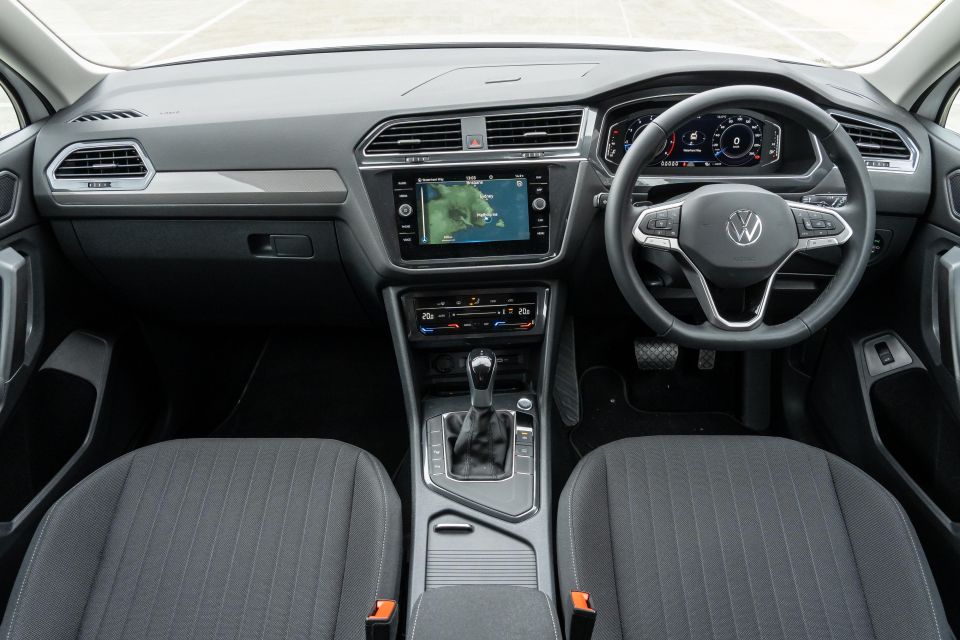
Volkswagen Tiguan
Don’t come to the Tiguan expecting excitement. It’s pretty dour in base guise, with a grey-on-grey colour scheme that makes even the Outlander look interesting.
What it lacks in excitement though, the Tiguan makes up for with its sheer competence.
The driving position is excellent, with plenty of support in the generously-padded cloth seats, and the steering wheel feels great in your hands. It’s trimmed in what feels like quality leather, and rather than touch sliders features proper buttons.
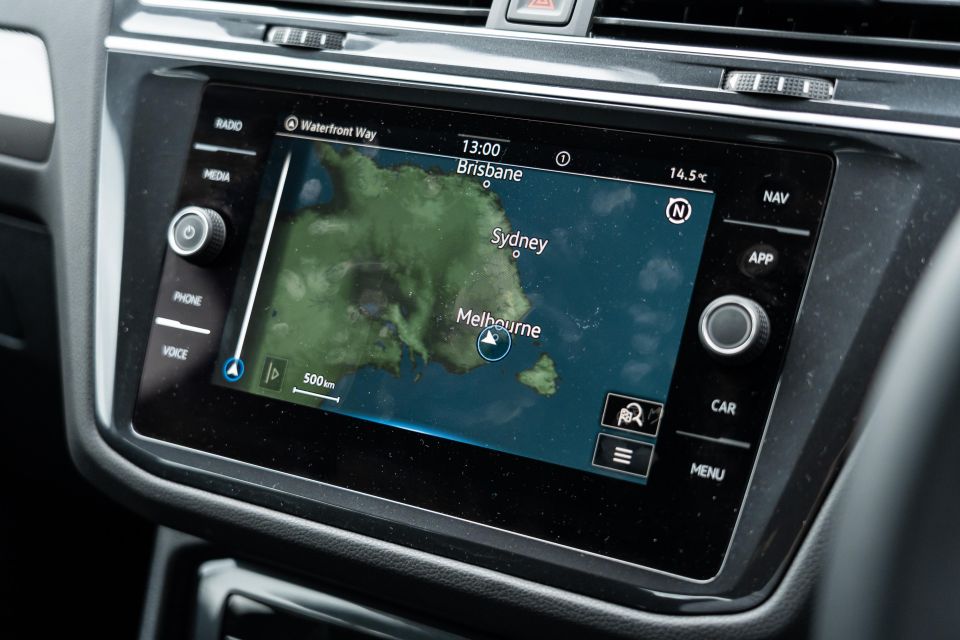
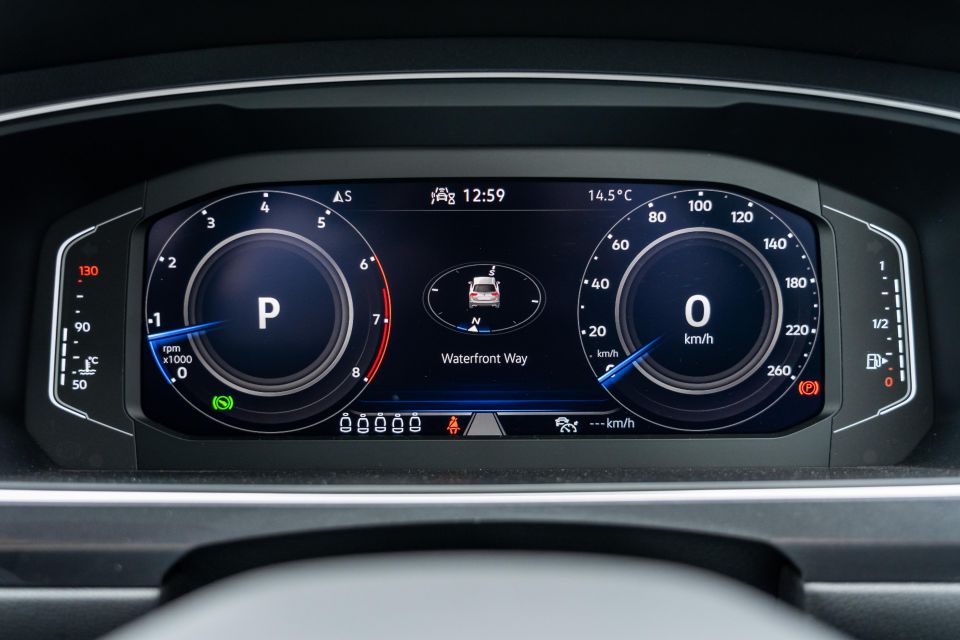
Unlike higher-end models with their widescreen displays, the base Allspace has an 8.0-inch touchscreen that looks a bit small in 2022. It makes up for it by having easily the best native software here, with wireless Apple CarPlay and Android Auto to boot.
It’s slicker than the system in the Outlander, and makes the Honda feel very old.
Volkswagen’s digital instruments are also excellent. Even in the base Allspace you’re able to have maps directly in the driver’s line of sight, and the range of different layouts on offer is best-in-class. The Outlander gains a digital cluster higher in the range than our tester, but even that isn’t as sophisticated as what’s on offer in the cheapest Tiguan.
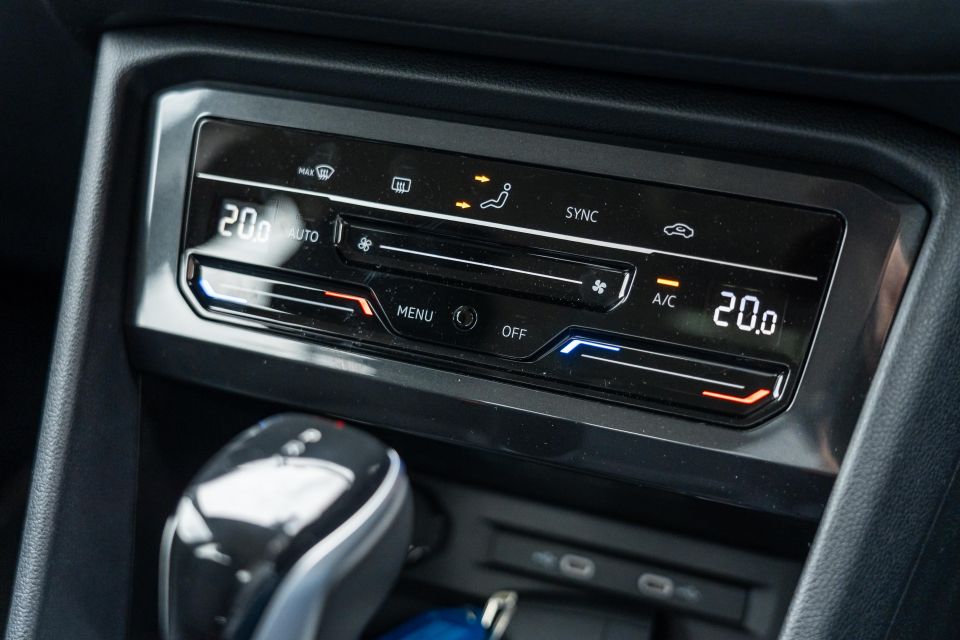
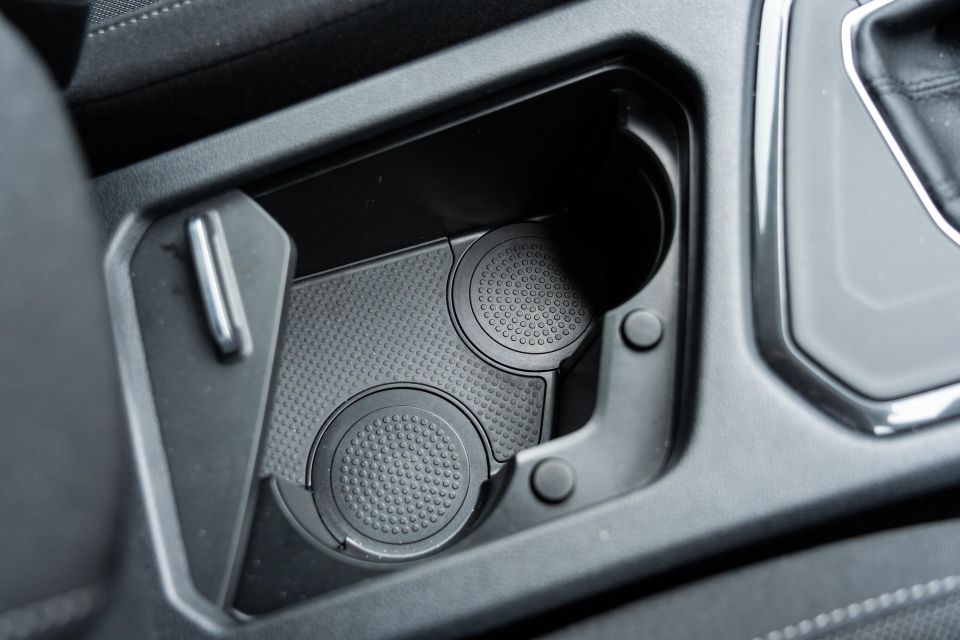
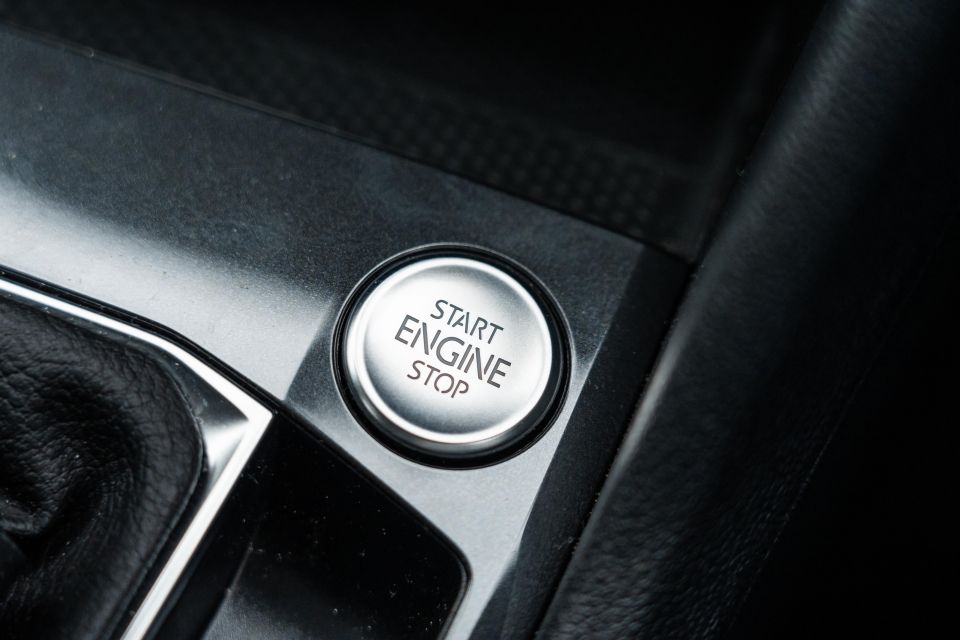
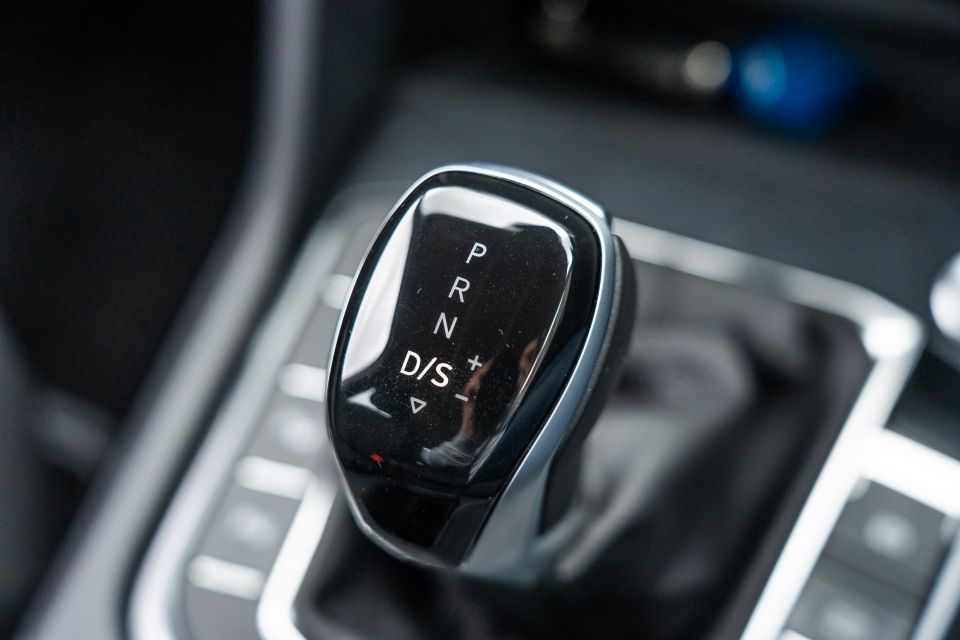
Unlike newer Volkswagen Group products, the Tiguan hasn’t had its dedicated climate control binnacle axed. Gone are the dials and buttons from the pre-update model, however, replaced with capacitive controls below the touchscreen.
There’s plenty of storage space up front, from the open space (with pop-out cupholders) on the transmission tunnel to the generous door pockets. Volkswagen also fits non-sunroof-equipped versions of the Allspace with a huge overhead console, like the world’s largest sunglasses holder.
The Tiguan has the most spacious second and third rows on test, which shouldn’t come as a surprise when you consider it has the longest wheelbase and body on this test.
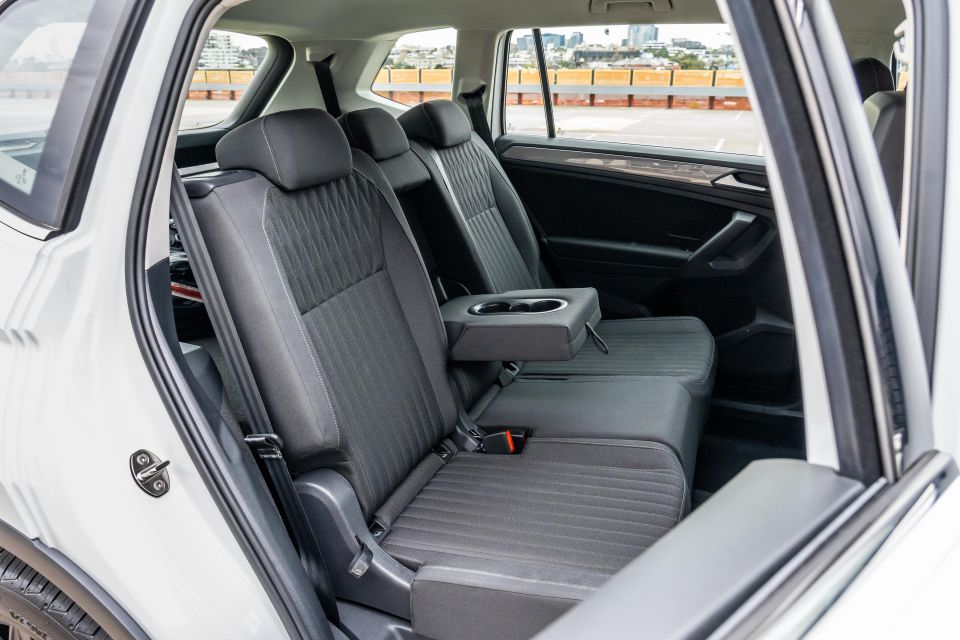
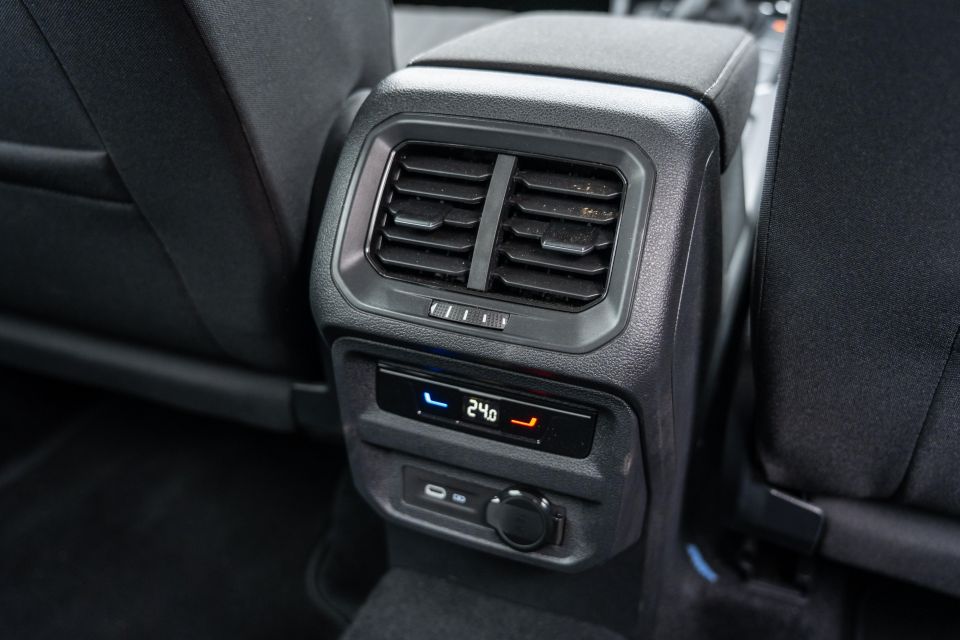
Legroom is better than either the Outlander or CR-V in the second row, as is headroom, and you get a USB-C charge port back there.
You also get vents with temperature controls, a fold-down armrest, and device pockets in the front seatbacks.
Access to the third row is relatively simple (the CR-V is simpler again), and once you’re there the amount of legroom will better accomodate older kids or teenagers. Headroom is similar to the Honda, but still outdoes the Outlander.
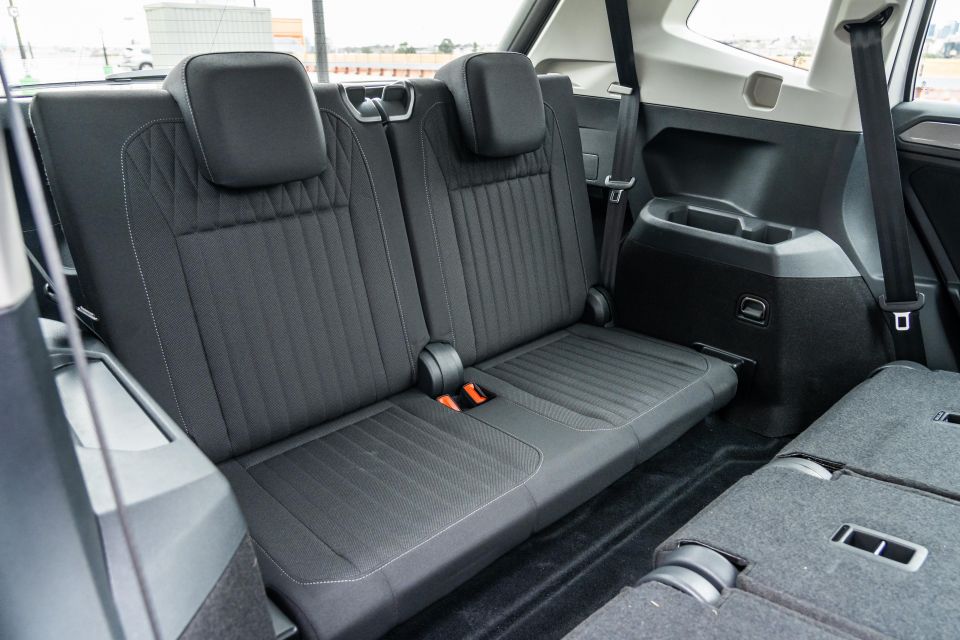
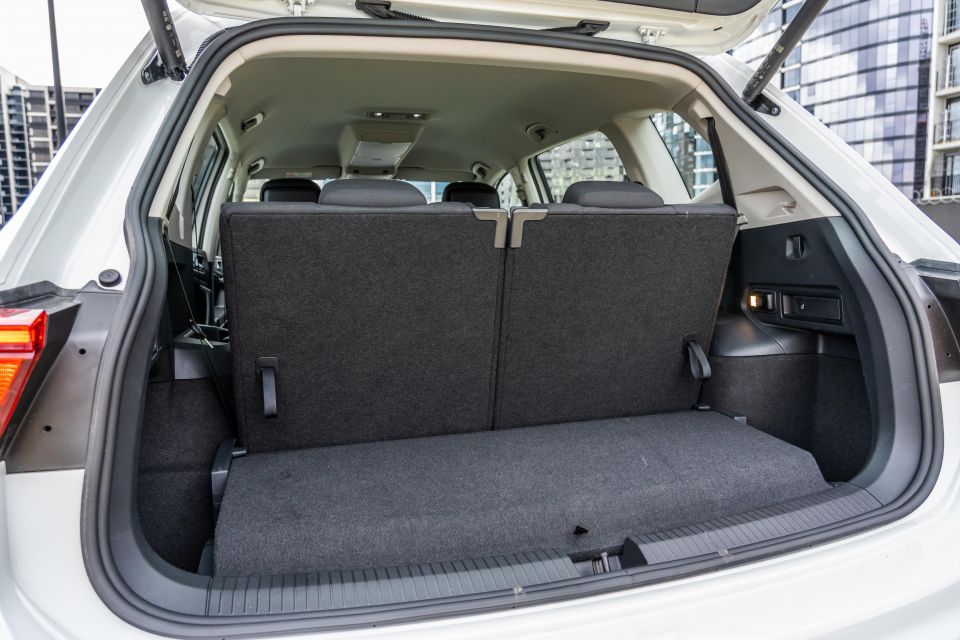
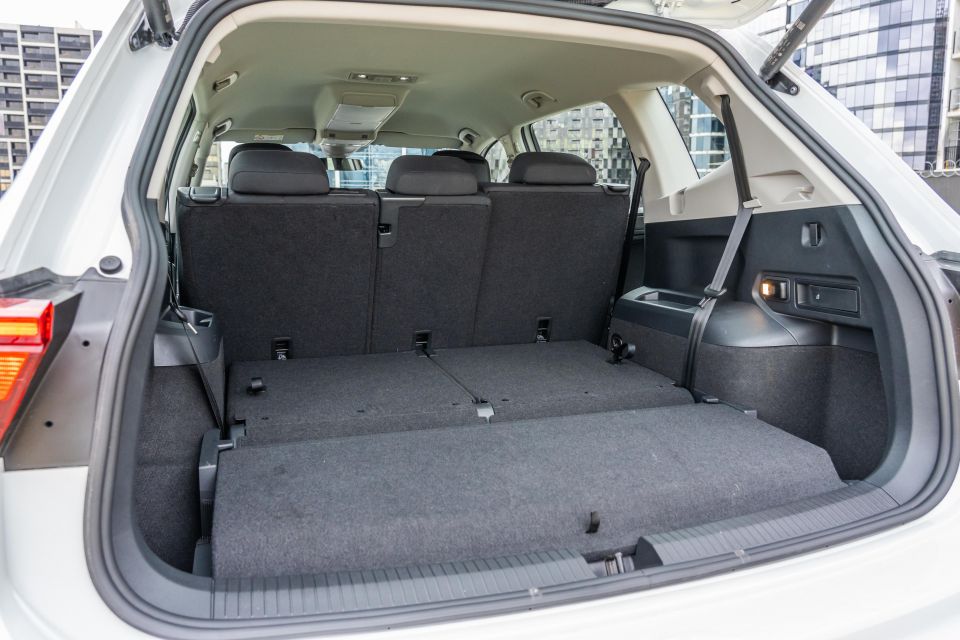
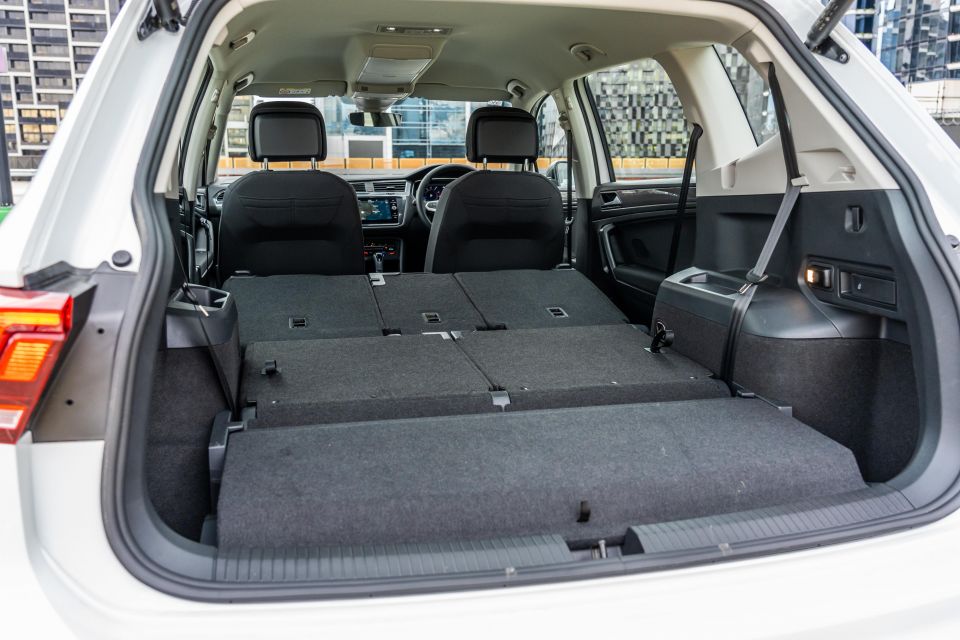
Raising or lowering the rear seats is simple, and when they’re flat you have a load bay that’s not quite as useful as the Outlander’s, but isn’t far off it.
The luggage cover fits beneath an insert in the floor, and the floor itself is close to flat. Beware the cutouts behind the wheel arches though; they’ll swallow loose items if you aren’t careful.
Volkswagen says there’s 230L of luggage space with all three rows up. This increases to 700L with the second row dropped and 1775L with the second and third rows folded.
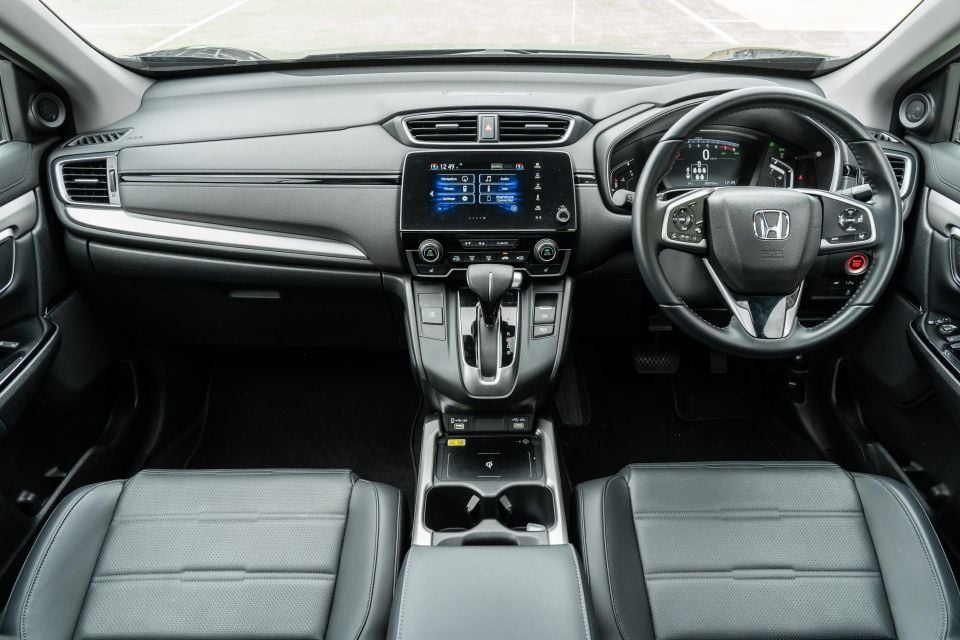
Honda CR-V
With a low loading lip for the boot, doors that open to 90 degrees, great all-round visibility, and acres of storage up front, the CR-V is dead easy to load, unload, and live with. It’s not a high-tech showpiece, but it does feel hard-wearing.
The driver and passenger sit high in well-stuffed, leather-trimmed seats with plenty of adjustment. The compact wheel looks and feels like a quality item, and even tall drivers will be able to get comfortable – while short drivers shouldn’t struggle to see out over the square-edged bonnet.
Despite its age, the fact this is a top-spec CR-V alongside lower-end rivals means the cabin looks and feels a bit more special. The heated leather seats in particular stand out.

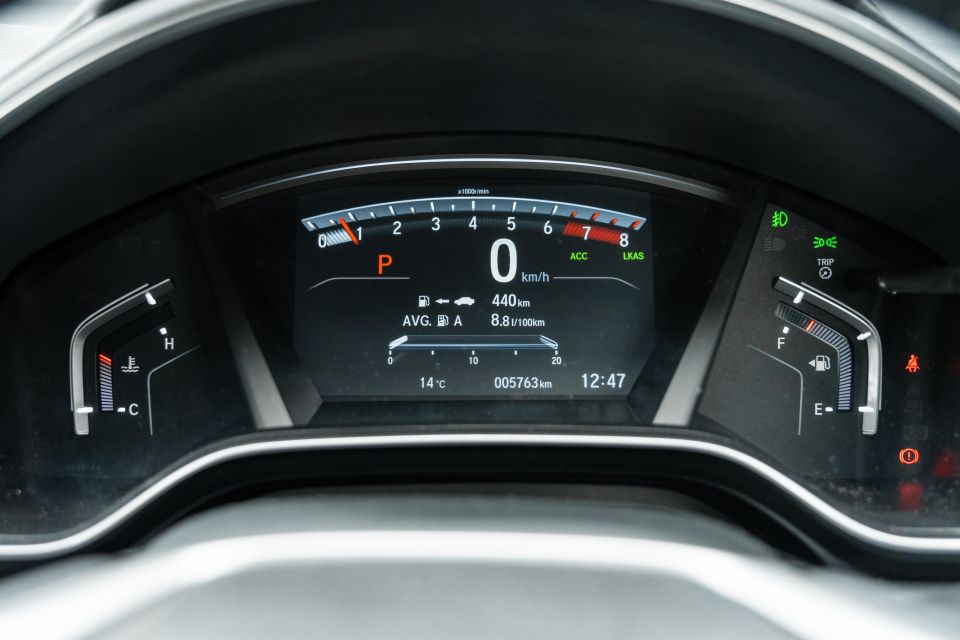
Sitting in the middle of the dashboard is a 7.0-inch infotainment screen that’s full-featured, but feels old alongside the displays in its rivals. The system is a step up on the aftermarket-looking unit from the smaller HR-V, but the graphics are basic and the responses slow.
The screen in the Volkswagen might not be much bigger, but it looks and feels far more modern when you dive in.
The CR-V misses out on digital radio, something reserved for the five-seat VTi LX AWD, and the factory navigation isn’t the last word in sophistication. The good news is, Honda gives you shortcut buttons and a proper volume knob.




Wired smartphone mirroring is the obvious solution, and allows you to more easily access media and mapping. The wireless charging pad wouldn’t play nice with my iPhone Pro Max, losing connection as the car accelerated or braked, so plugging in for Apple CarPlay isn’t the worst thing in the world.
The driver is faced with a clear, simple digital instrument cluster with a retro bar-style rev counter. Flanking it are two funky-looking gauges for engine temperature and fuel.
It’s clear and easy to read on the move, and throws back to Hondas of yore like the S2000 with its bar-style rev-counter – not that you’ll spend all that much time chasing the redline here. It’s arguably nicer to look at than the setup in the Mitsubishi, but the Volkswagen has it well and truly covered.
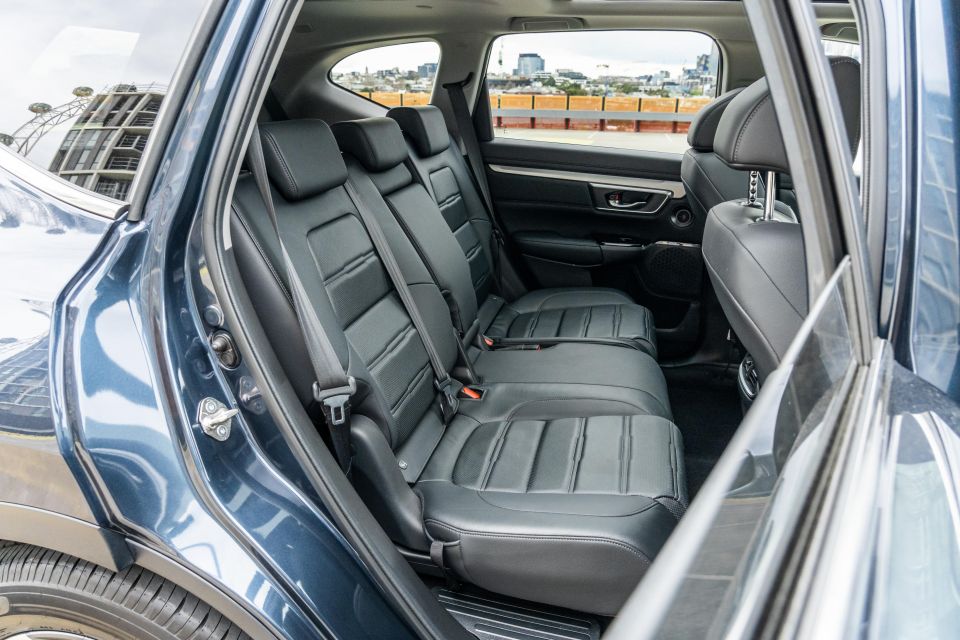

The amount of storage Honda has managed to fit into the CR-V’s body is impressive. The centre console is home to a massive bin (big enough for a handbag or laptop), and the sliding cover is actually an L-shaped tray for your wallet or phone. It’s a clever touch none of its rivals can match.
Access to the rear seats comes courtesy of big doors that open to 90 degrees, making it easier to load in child seats. Legroom is better than in the Outlander, but headroom is hit hard by the addition of a sunroof. Tall passengers will need to angle their heads, something you don’t need to do in the non-sunroof-equipped model.
Both the Tiguan and Outlander have significantly more headroom, which is disappointing given the CR-V trades on its practicality. Culling the sunroof partially solves the problem, but that would undermine the car’s pitch as a luxury alternative to its more expensive rivals.
There are two USB ports on the back of the transmission tunnel, along with air vents. With large windows and high-set rear seats, small children should have no trouble seeing out, and the cabin feels light and airy. It’s clear the CR-V was designed with families in mind. There are two ISOFIX and two top-tether mounts for child seats.
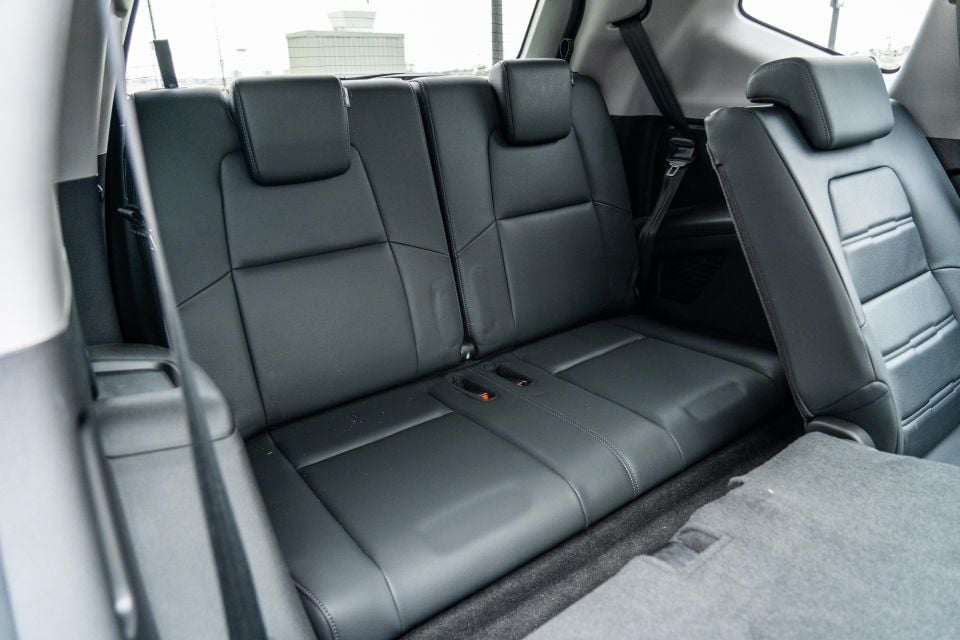
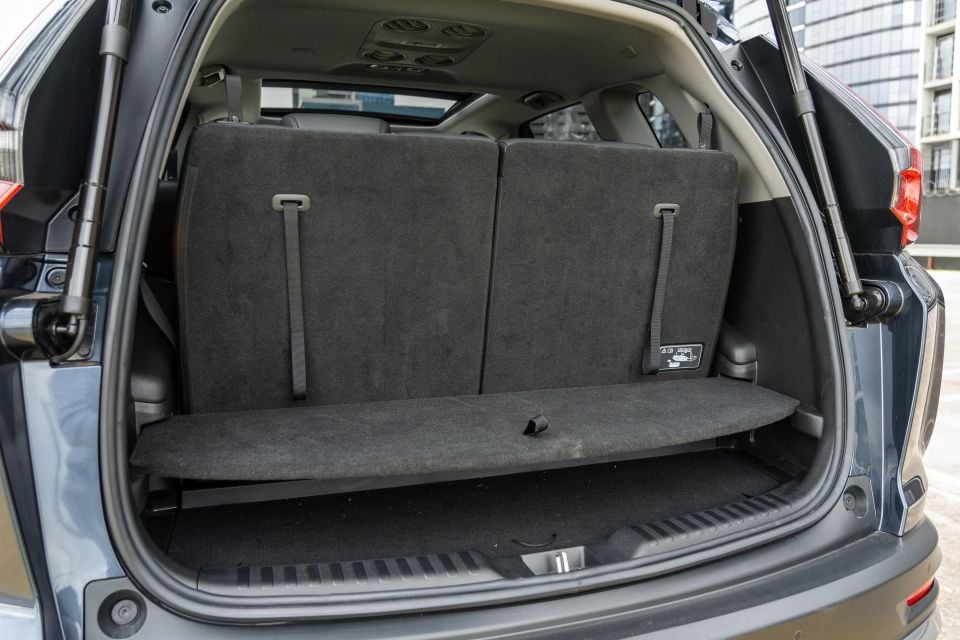
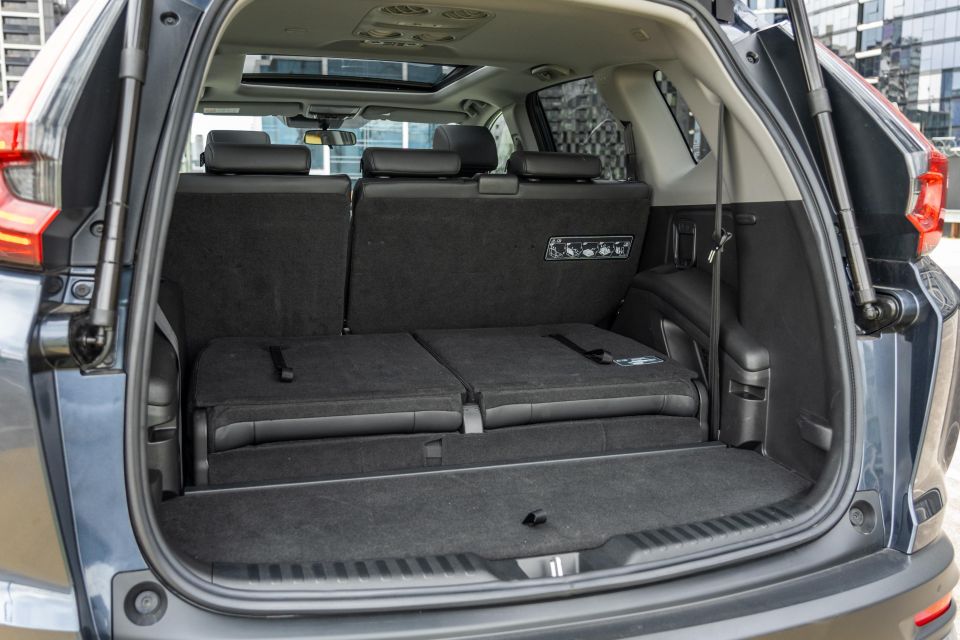
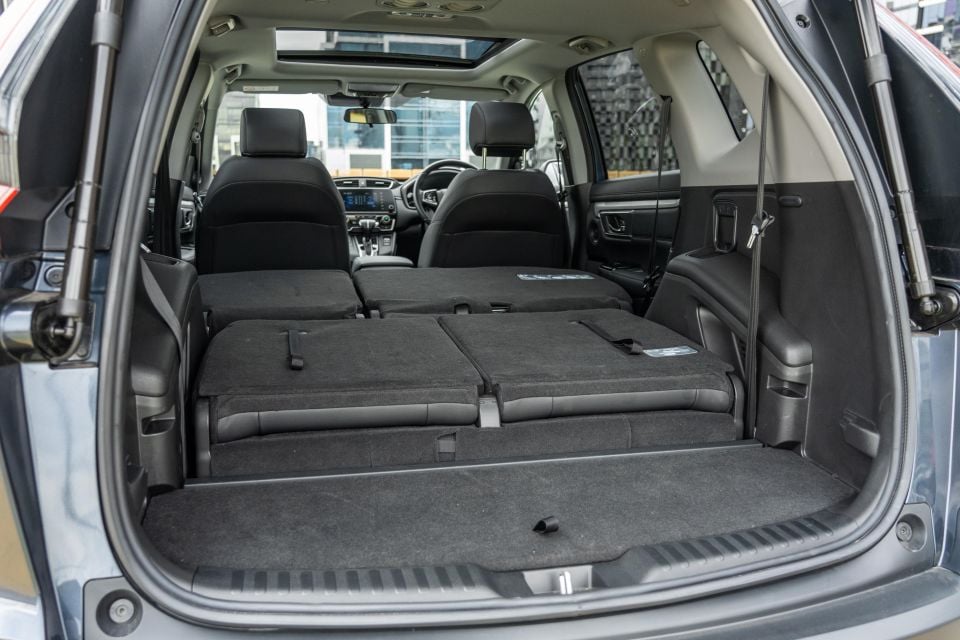
Access to the third row is simple thanks to the sliding and tumbling second row. It’s the easiest car to clamber into, and when you’re in there’s similar levels of headroom to the Tiguan – albeit with slightly less legroom. This is the only car here with rear vents, which for some will be a deal-maker.
The boot is compromised by the addition of two extra seats. Unlike the five-seater, with its low and flat floor, the seven-seat CR-V has a stepped boot that can be levelled out with an extra insert. It’s the least useful space here.
Boot space ranges from a tight 150L with the third row in place to 472L with it folded, and 936L (measured to the window line, not the roof) with the second row folded flat.
| Mitsubishi | Volkswagen | Honda | |
|---|---|---|---|
| Length | 4710mm | 4734mm | 4635mm |
| Width | 1862mm | 1839mm | 1855mm |
| Height | 1740mm | 1689mm | 1679mm |
| Wheelbase | 2706mm | 2791mm | 2660mm |
| Boot space | 163/478/1461L | 230/700/1775L | 150/472/936L |
| Weight(tare) | 1720kg | 1613kg | 1607kg |
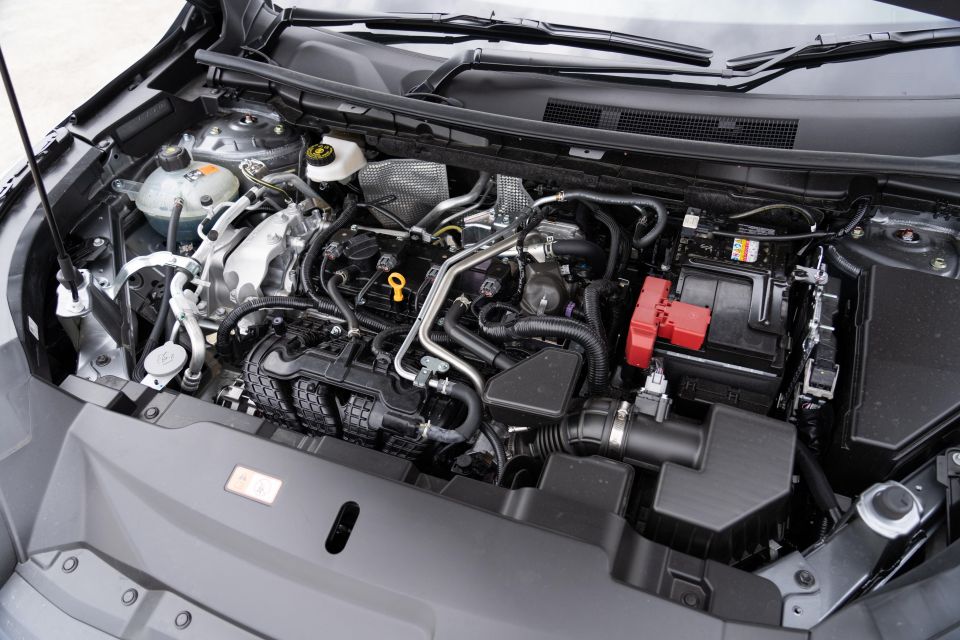
Mitsubishi Outlander
Power in the Outlander comes from a 2.5-litre naturally-aspirated four-cylinder petrol engine. It makes 135kW of power and 245Nm of torque, and is sent to the front wheels through a CVT.
All-wheel drive is offered on this model, although you’ll have to pay an extra $2500 for the privilege.
Claimed fuel economy is 7.7 litres per 100km, and the car has a 55L fuel tank. It drinks 91 RON regular unleaded.

Volkswagen Tiguan
Power in the base Tiguan 110TSI comes from a 1.4-litre turbocharged four-cylinder petrol engine. It makes 110kW of power and 250Nm of torque, sent to the front wheels through a six-speed dual-clutch transmission.
All-wheel drive is offered elsewhere in the Tiguan Allspace range, but you need to spec the 132TSI, 162TSI, or 147TDI engines.
Claimed fuel economy is 7.7 litres per 100km, and the car has a 58L fuel tank. It drinks 95 RON premium unleaded.
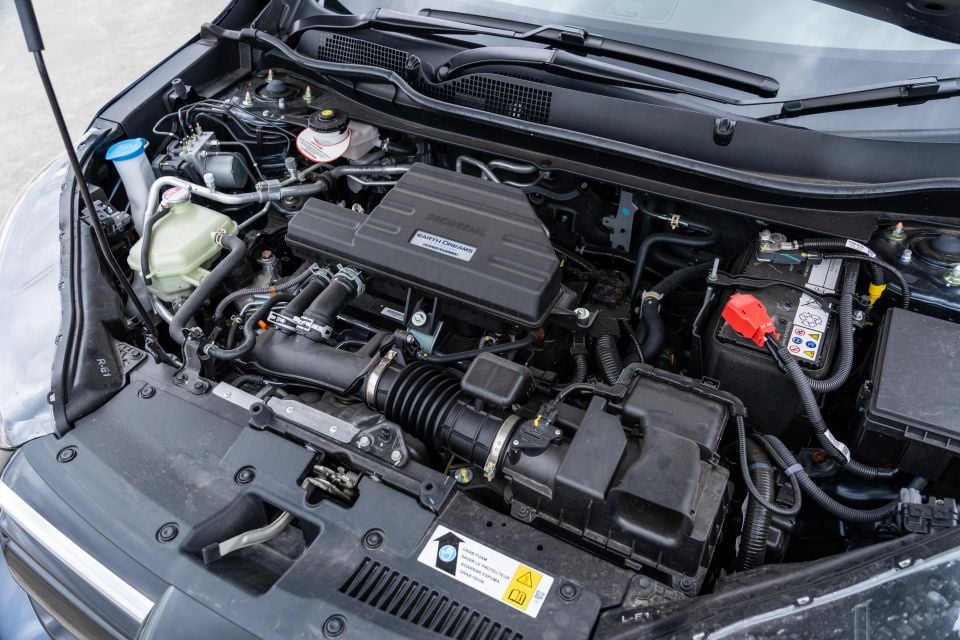
Honda CR-V
Power across the Honda CR-V comes from a turbocharged 1.5-litre four-cylinder petrol engine. It makes 140kW of power and 240Nm of torque, sent to the front wheels through a CVT.
All-wheel drive is offered on five-seat models, but the seven-seat range is front-wheel drive only.
Claimed fuel economy is 7.3 litres per 100km, and the car has a 57L fuel tank. It drinks 91 RON regular unleaded.
| Mitsubishi | Volkswagen | Honda | |
|---|---|---|---|
| Engine | 2.5L atmo four-cyl | 1.4L turbo four-cyl | 1.5L turbo four-cyl |
| Fuel | Petrol (91 RON) | Petrol (95 RON) | Petrol (91 RON) |
| Power | 135kW | 110kW | 140kW |
| Torque | 245Nm | 250Nm | 240Nm |
| Transmission | CVT | Six-speed DSG | CVT |
| Drive type | FWD | FWD | FWD |
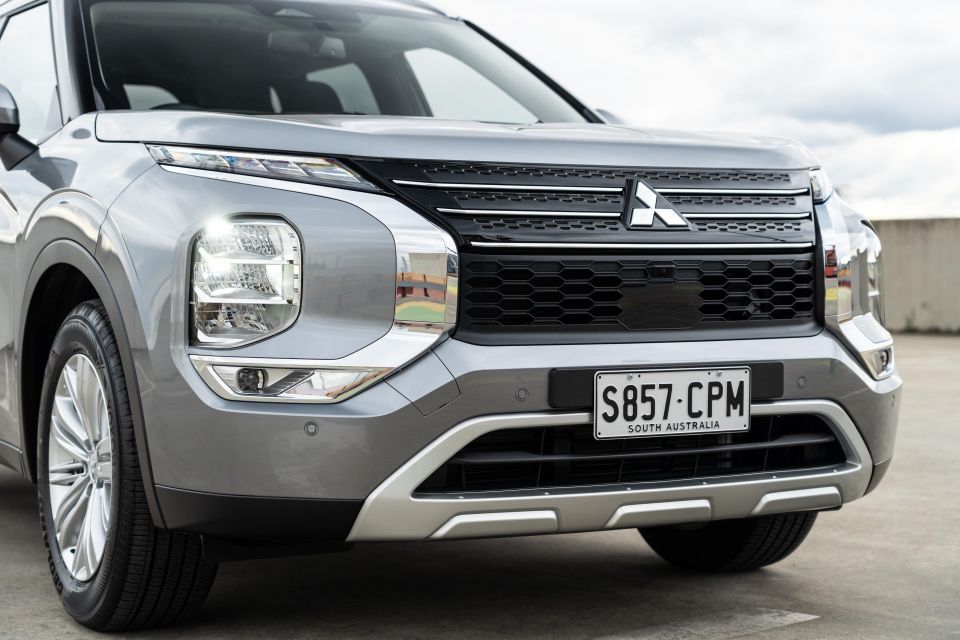
Mitsubishi Outlander
The last Outlander was solid but unremarkable on the road, and the new car follows in those footsteps.
It’s more refined than before though, with a big-car feel that’ll endear it to the sort of people who covet a commanding view of the road ahead.
That’s not to say it’s a truck. With light steering and decent all-round visibility, it’s an easy car to thread through tight city streets or underground carparks despite its size, and the reversing camera offers a decent view of what’s behind you.
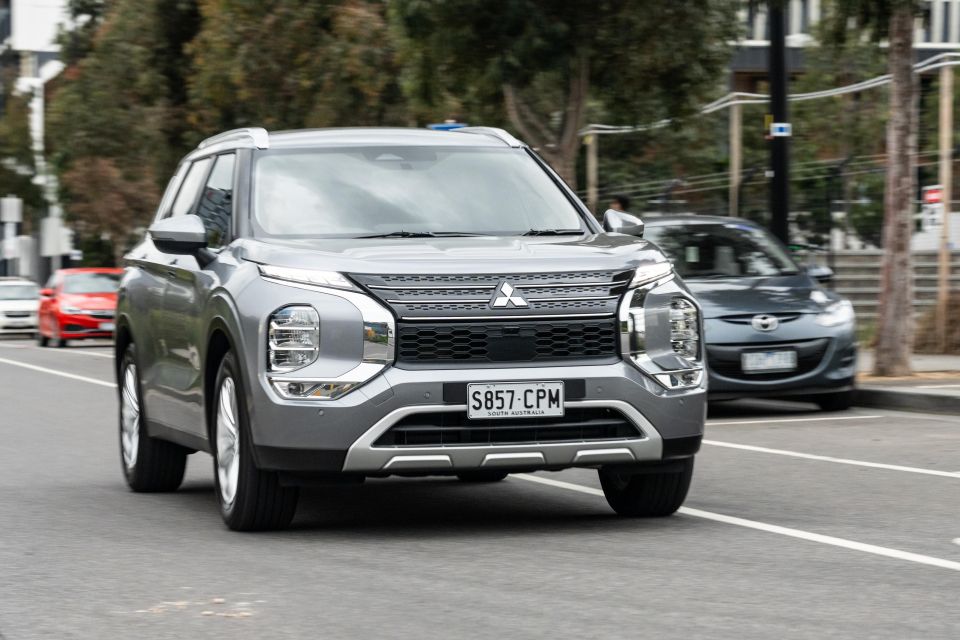
It’s hard to understand why it’s mounted slightly off-centre, given this is close to a brand-new car, but it doesn’t warp your perspective too much.
As you’d expect of a low-power, non-turbo engine mated with a CVT, the powertrain in the Outlander is adequate but nothing more. In normal driving it’s unobtrusive, and generally operates in a band between 2000 and 3000rpm where you don’t get much in the way of noise or vibrations.
Ask for more than gentle progress and you get more revs and more noise, but not all the much more of a shove in the back. Compared to the CR-V, which has a decent slug of turbo torque in the mid-range, it needs to rev higher to deliver its performance.
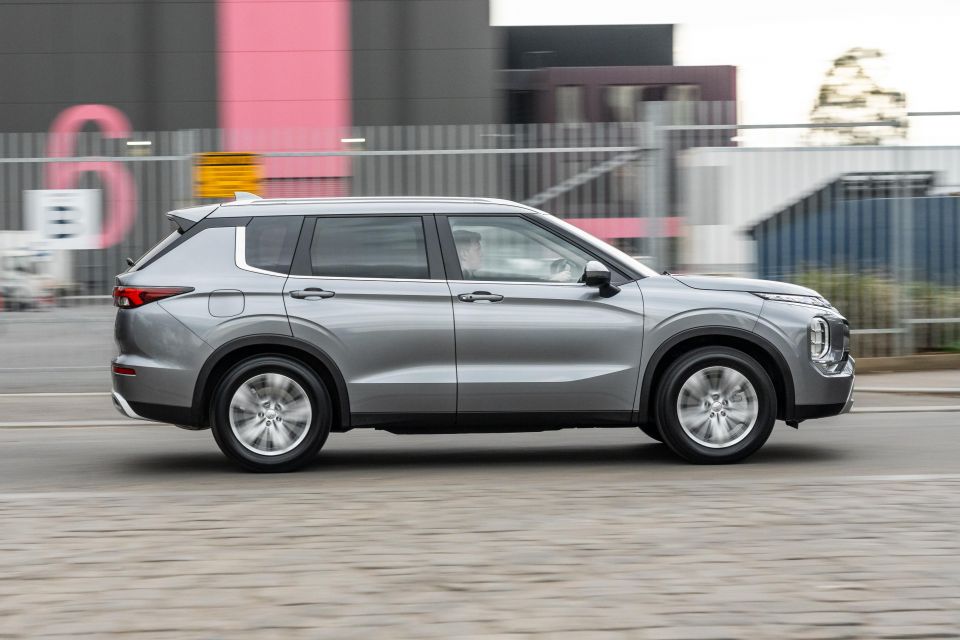
Although the CVT gamely tries to mimic a torque converter by slurring through fake gear shifts under heavy throttle, there’s nothing pleasant about the way the Outlander delivers its performance with two people on board, let alone seven.
We’ve criticised the ride quality on more expensive Outlander models with bigger wheels, but it’s pretty good on the LS. It floats over small city bumps nicely, and never feels busy like some of its more expensive range-mates.
That relaxed suspension tune makes the car a long-legged cruiser for the most part, although it does crash into sharp bumps and expansion joints harder than it really should. It can also float over crests and dips, taking a moment longer than the Tiguan and CR-V to settle.
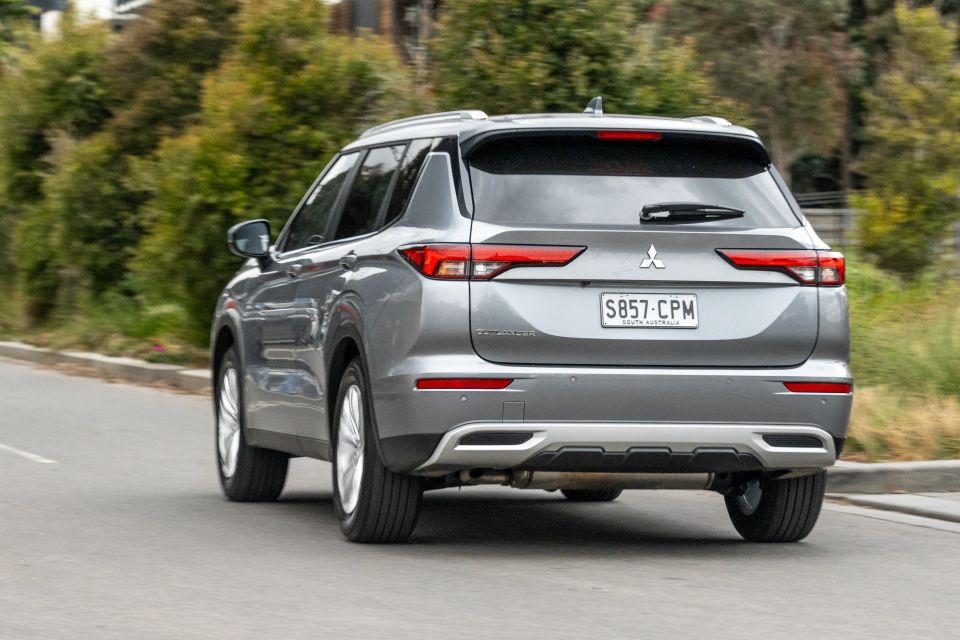
Noise suppression is impressive at 100km/h on average country roads, and the engine is settled at a cruise.
Mitsubishi’s suite of driver assists is solid, but not standout. The adaptive cruise control is smooth and smart, but the lane-keeping assist system is quite relaxed and won’t actively centre the car if you aren’t bumping into the white lines.
This is comfortably the newest car of the three on test, so it’s hard to understand why technology rolling out elsewhere in the segment isn’t offered.
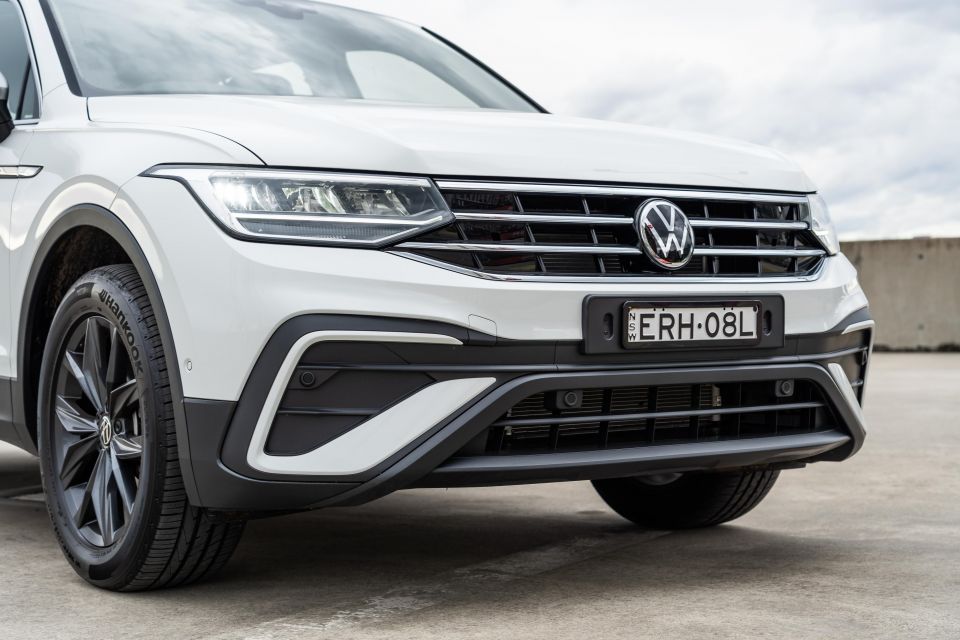
Volkswagen Tiguan
The Tiguan feels distinctly different to the other two cars on test with its dual-clutch transmission and 1.4-litre engine.
The six-speed DSG can be slightly hesitant off the mark, but once you’re rolling it shifts quickly and smartly, and delivers a more natural feeling than the CVTs in the Outlander and CR-V.
You don’t get awkward hovering revs or ugly, noisy flares, and it kicks down quickly when you’re in a hurry to deliver the healthiest shove in the back here. The fact it revs out smoothly, backed by a muted growl, is a bonus for anyone who likes driving.
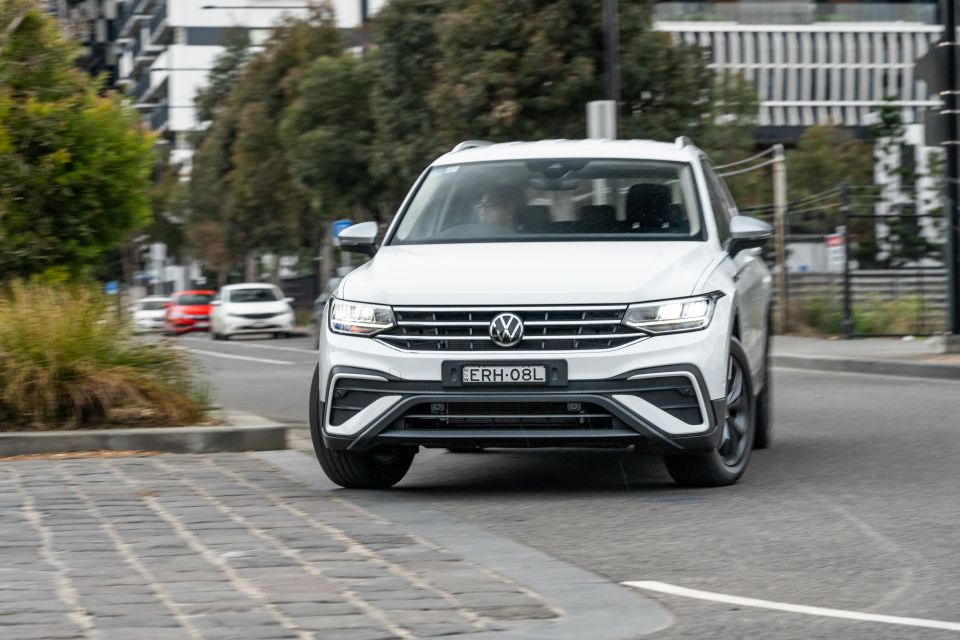
With no paddle shifters, you need to use the shifter to bang through the gears manually. This is the only car here where there’s a benefit to taking manual control, with crisp downshifts and snappy upshifts.
Volkswagen offers more powerful engines elsewhere in the range, and we’d still be springing for the 132TSI with all-wheel drive given the choice, but the front-wheel drive 110TSI doesn’t feel too much like a poor relation.
With typically light steering at low speed, the Allspace is easy to place in tight spaces. It feels bigger than the CR-V, but it’s not going to make anyone stepping up from a five-seat Tiguan uncomfortable.
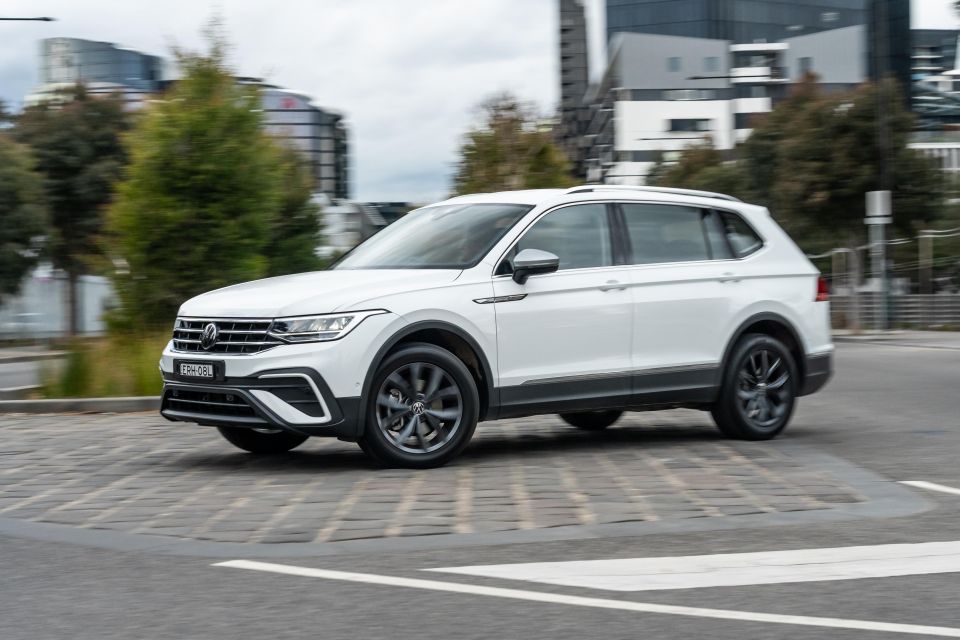
A bigger screen would be nice, but the quality of the rear-view camera is the best of the three cars here. It’s centred, and offers a clearer picture in low light than either the CR-V or Outlander.
Ride quality on the standard 18-inch alloy wheels is excellent in town, filtering out all the nasty little bumps you find in the city, and it settles into a relaxed cruise at highway speeds.
What you lose in the Allspace, at least relative to the five-seat Tiguan, is the feeling you’re piloting an overgrown Golf. It’s still wieldy enough in town, and it’s far from a barge in the corners, but the extra length of the Allspace is apparent at times,
Of course, that extra length pays dividends if you’re going to haul around overgrown teenagers all day long, or make use of the third row.
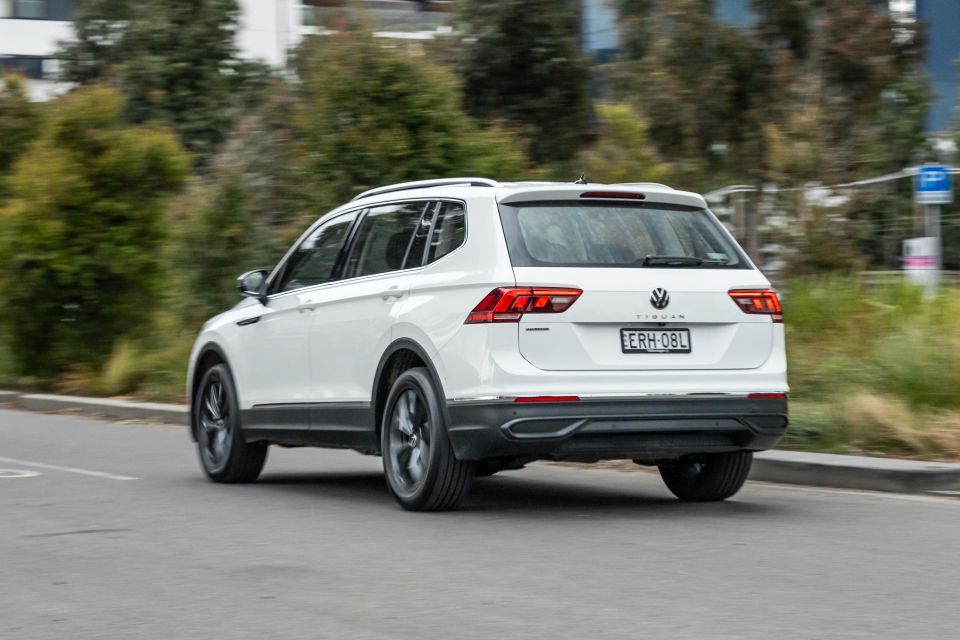
Unlike some more expensive versions of the Tiguan on wider tyres, the Allspace on its comfort-oriented rubber shrugs off coarse chip highways without any issue. It’s quieter at 100km/h than the CR-V, and is on par with the Outlander.
Volkswagen’s adaptive cruise and lane-keeping are the best calibrated here. The lane-keeping doesn’t intervene until it’s actually required, and it’s smooth when it does step in. Likewise the adaptive cruise, which wasn’t afflicted by the phantom braking we saw in the CR-V.

Honda CR-V
The CR-V might look a bit tall and boxy, but it drives like a smaller and lighter car.
The 1.5-litre turbocharged engine might have a small displacement, but its peak torque figure is healthy enough, and it comes on tap at just 2000rpm. That means it feels relatively effortless at city speeds, the CVT holding revs between 2000 and 2500rpm to keep the engine humming smoothly along.
It’s more responsive than you might expect, although the combination of a CVT and small-displacement turbo engine means it can take a second to gather itself and offer a proper shove in the back when you demand more.
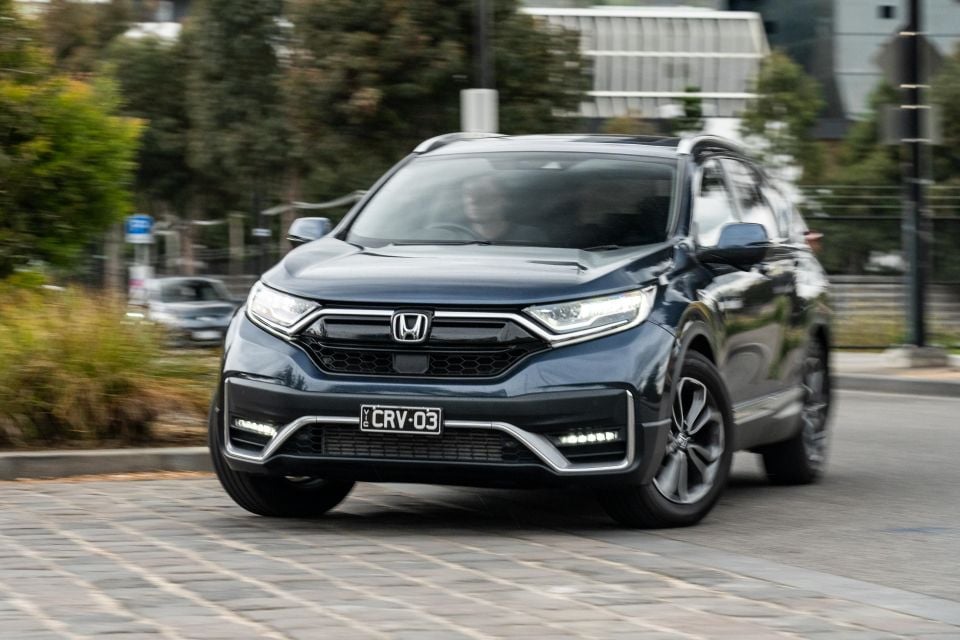
There’s hardly any engine noise in normal driving, and vibrations are kept in check from behind the wheel. It gets noisy when you really put your foot down, as is common in cars with a CVT, but it’s a nicer powertrain than the one in the Outlander.
Honda offers all-wheel drive on its five-seat models, but unless you’re often heading to the snow or along muddy fire trails to surf spots it’s not really necessary. Even on a wet week the CR-V never broke traction, and the linear throttle calibration means you’re not going to accidentally overwhelm the tyres with an accidental spike of torque.
With tall windows and an upright body, the CR-V is one of the easier SUVs to place in tight city streets. The steering is light and fluid, and you get a reversing camera and parking sensors to help squeeze into smaller spaces.
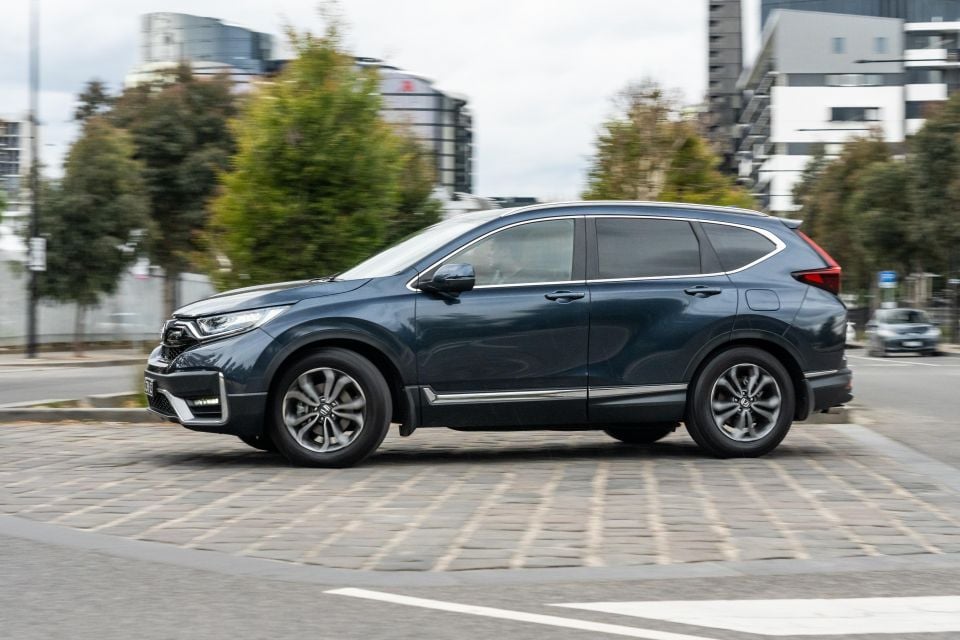
The camera is fairly low-resolution and squeezed by the small central screen, which won’t impress tech-heads.
Honda has done a decent job keeping wind and road noise at bay, but there’s a lot more road roar than in the most refined car of our trio, the Tiguan, and a bit more than in the Outlander.
The adaptive cruise system is generally smoothly-tuned, but it occasionally shadow brakes to avoid cars in parallel lanes. It’s hard to override, but it’s a bit annoying when the car randomly jabs the brakes and you’re not expecting it.

Honda’s lane-keeping assist acts smoothly, and is not too intrusive. Despite its age, the CR-V doesn’t feel far off its newer rivals on the highway.
Given the CR-V rides on 18-inch alloy wheels, ride quality is impressive. It feels relaxed over city bumps and potholes, dealing with them without any unseemly bashing or crashing.
It also deals well with bigger dips or crests on the open road, brushing them off in one tight motion.

Mitsubishi Outlander
The Outlander has a five-year/100,000km warranty as standard, but it’s extended to 10 years and 200,000km if you service in the Mitsubishi dealer network using its capped-price service program.
Maintenance is required every 12 months or 15,000km, whichever comes first. The first five services cost a combined $995 on the Mitsubishi capped-price service plan.

Volkswagen Tiguan
The Tiguan is backed by a five-year, unlimited-kilometre warranty.
Maintenance is required every 12 months or 15,000km, whichever comes first. The first five services cost $2200 using a Volkswagen service plan.

Honda CR-V
The CR-V is backed by a five-year, unlimited-kilometre warranty.
Maintenance is required every 12 months or 10,000 kilometres, whichever comes first. The first five services cost just $125 each, for a combined five-year service cost of just $625.
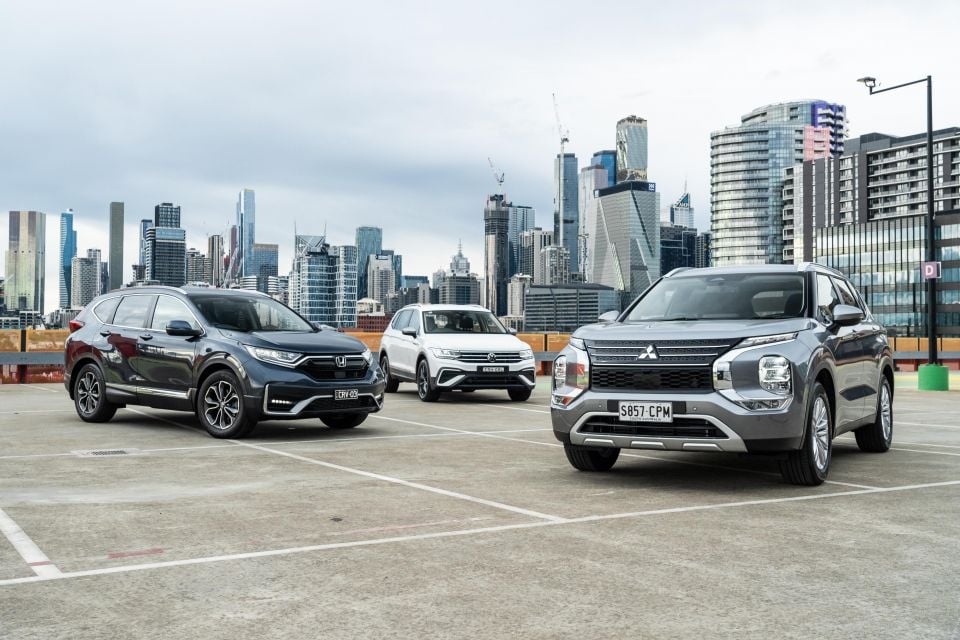
Each of the three cars on test here makes a strong case for itself… but before we go any further, it’s worth noting none of them is going to suit someone using the third row all the time. They’re all still 5+2 seaters.
The CR-V is the oldest car here, but it still has plenty going for it. It’s a good size if you live in the city, drives with polish, and is more practical than you’d expect in the third row.


The lack of second-row headroom and the stepped boot undermine its overall practicality, and it’s showing its age in a few places. It’s worth a look, but it’s not the winner of our comparison.
Splitting the Outlander and Tiguan Allspace is more difficult than expected.
Mitsubishi has improved the Outlander significantly compared to its ageing predecessor. It’s more spacious inside, more refined on the road, and packs a more up-to-date technology suite behind the wheel.
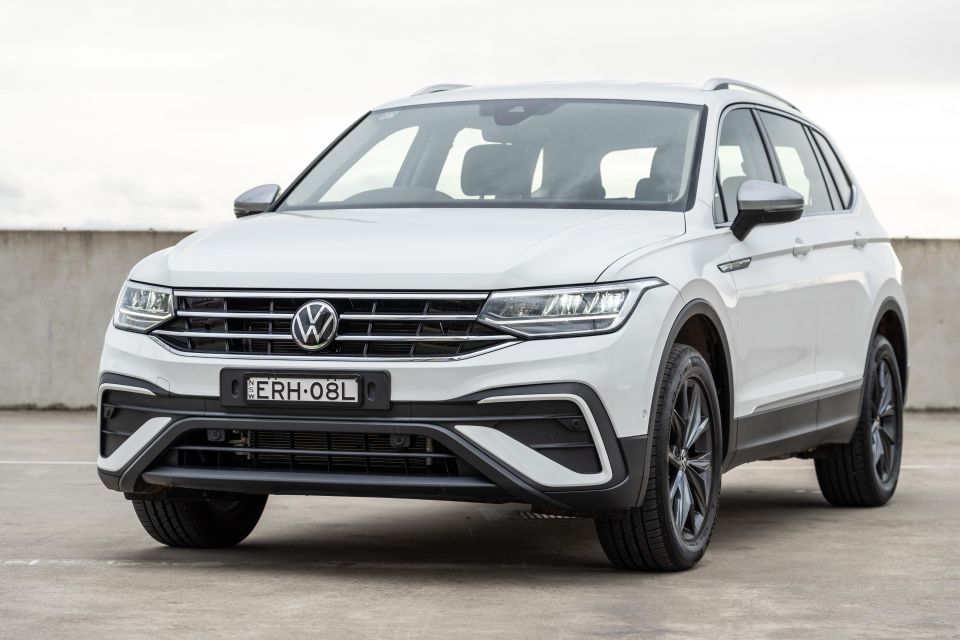
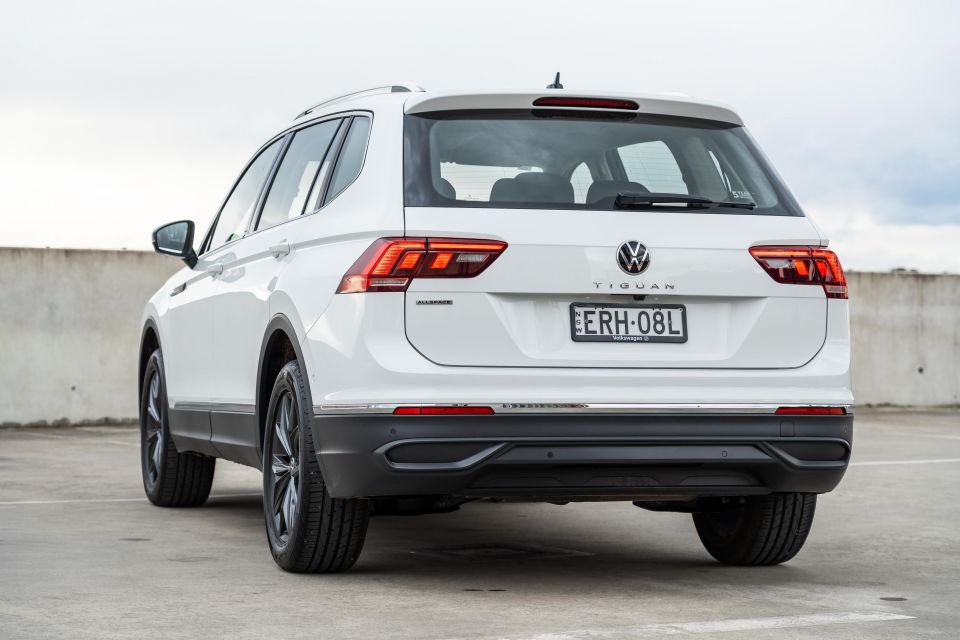
We’ve a sneaking suspicion it really should be better, though. The technology is fine, but it’s not nearly as flash as you’d expect of a brand-new car. The third row should also be better than it is.
The Tiguan is the most practical car here, and the most refined to drive. It’s not particularly exciting, but that isn’t really what Volkswagen’s base models are all about anyway.
Why didn’t it win? Based on drive-away prices the Outlander is around $3500 cheaper than the Tiguan, and it’s significantly cheaper to maintain over the first five years of ownership. It also packs a better warranty, which is hard to overlook.
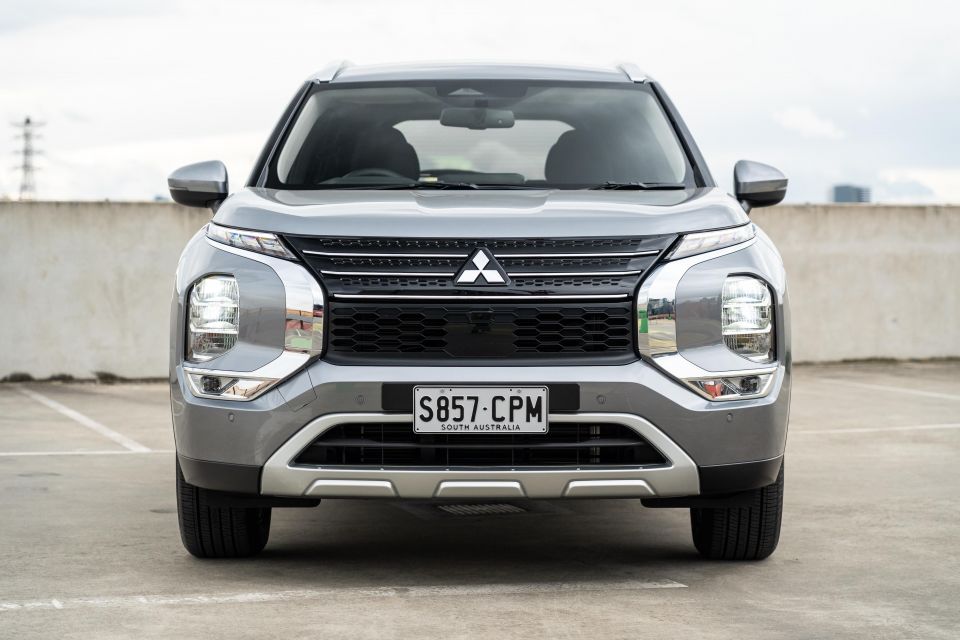
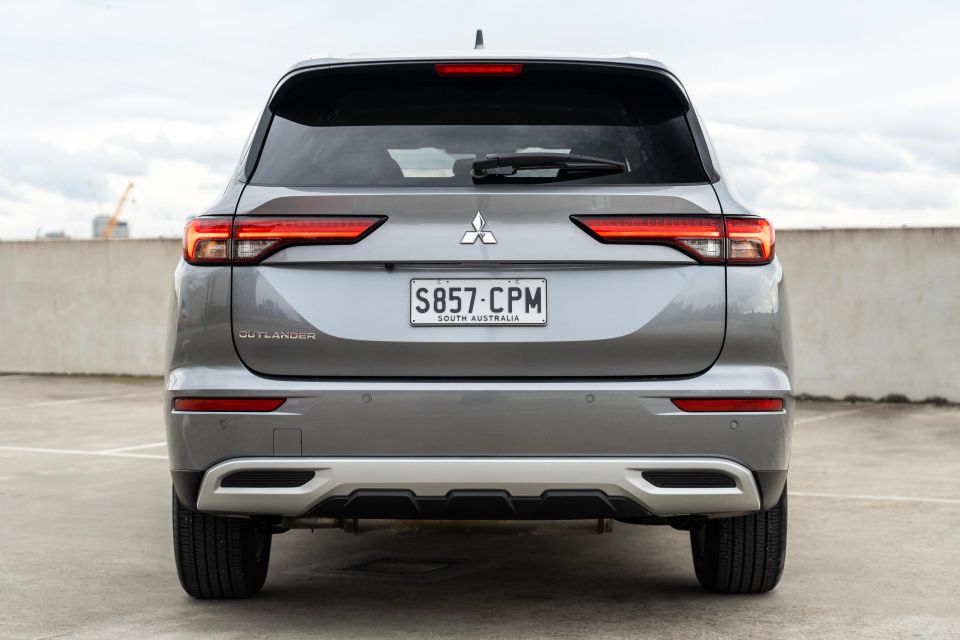
MORE: Everything Mitsubishi Outlander MORE: Everything Volkswagen Tiguan MORE: Everything Honda CR-V
Share your thoughts with us in the comments below!
Scott Collie is an automotive journalist based in Melbourne, Australia. Scott studied journalism at RMIT University and, after a lifelong obsession with everything automotive, started covering the car industry shortly afterwards. He has a passion for travel, and is an avid Melbourne Demons supporter.
Share your thoughts and write a review of a car you own and get featured on CarExpert.


William Stopford
8 Hours Ago


Max Davies
8 Hours Ago
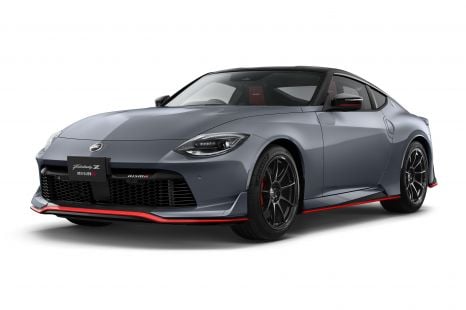

Derek Fung
9 Hours Ago
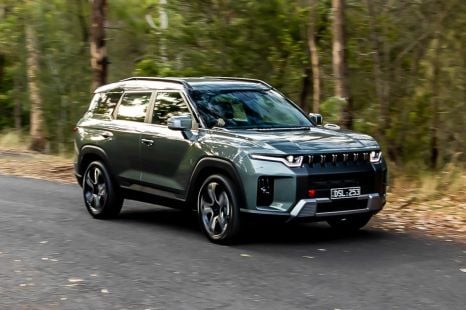

Matt Campbell
16 Hours Ago


Ben Zachariah
1 Day Ago


Damion Smy
1 Day Ago